Welcome to Wellness Archive
<< Welcome to Wellness Home | College Wellness Home
May 2, 2022
GRADUATION MONTH

We wish the graduating students of The University of Toledo health and wellness now and in the future and close with the poem Desiderata:
GO PLACIDLY amid the noise and the haste, and remember what peace there may be in silence. As
far as possible, without surrender, be on good terms with all persons.
Speak your truth quietly and clearly; and listen to others, even to the dull and the
ignorant; they too have their story.
Avoid loud and aggressive persons; they are vexatious to the spirit. If you compare
yourself with others, you may become vain or bitter, for always there will be greater
and lesser persons than yourself.
Enjoy your achievements as well as your plans. Keep interested in your own career,
however humble; it is a real possession in the changing fortunes of time.
Exercise caution in your business affairs, for the world is full of trickery. But
let this not blind you to what virtue there is; many persons strive for high ideals,
and everywhere life is full of heroism.
Be yourself. Especially do not feign affection. Neither be cynical about love; for
in the face of all aridity and disenchantment, it is as perennial as the grass.
Take kindly the counsel of the years, gracefully surrendering the things of youth.
Nurture strength of spirit to shield you in sudden misfortune. But do not distress
yourself with dark imaginings. Many fears are born of fatigue and loneliness.
Beyond a wholesome discipline, be gentle with yourself. You are a child of the universe
no less than the trees and the stars; you have a right to be here.
And whether or not it is clear to you, no doubt the universe is unfolding as it should.
Therefore be at peace with God, whatever you conceive Him to be. And whatever your
labors and aspirations, in the noisy confusion of life, keep peace in your soul. With
all its sham, drudgery and broken dreams, it is still a beautiful world. Be cheerful.
Strive to be happy.
April 25, 2022
FINANCIAL WELLNESS
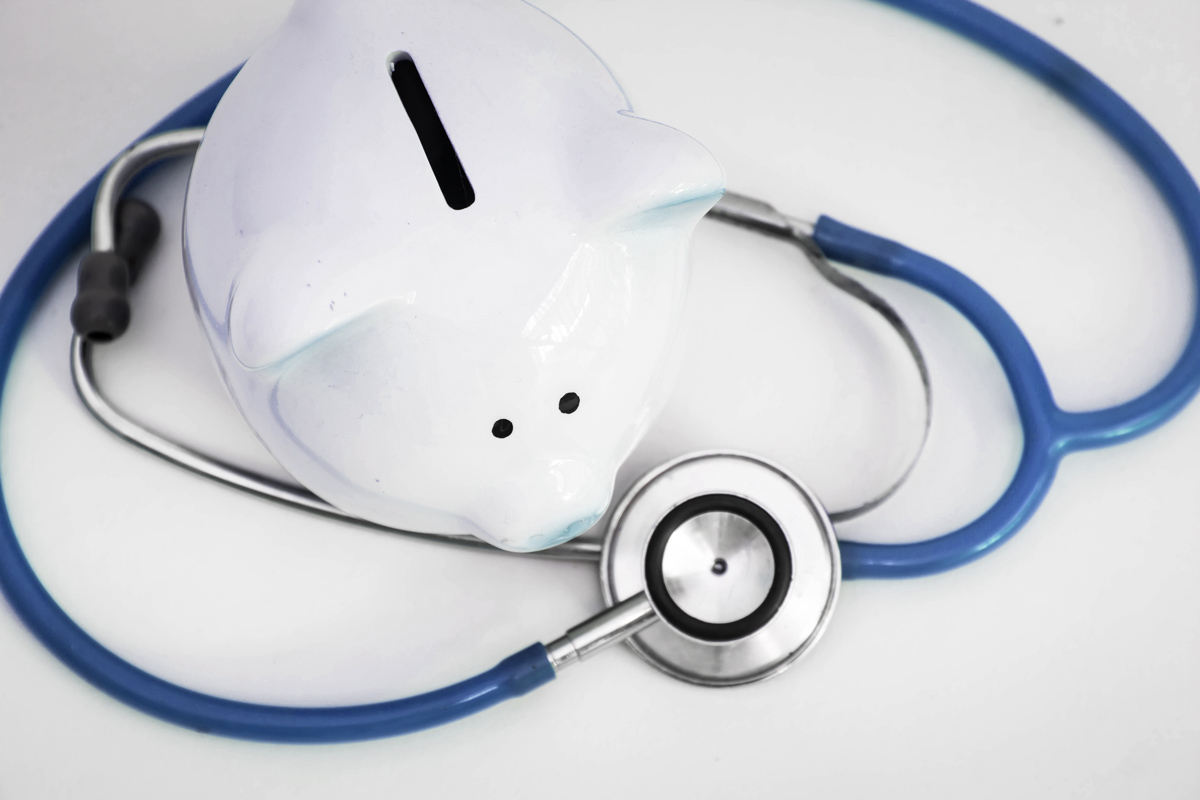
Financial wellness isn’t about retirement planning or money in a savings account.
It’s really about your attitude towards and relationship with money.
Do you feel financially secure and knowledgeable? Or do you feel stressed and helpless?
While there are many plans and strategies to help you manage your finances, here are
some tips from the Consumer Financial Protection Bureau:
- To understand where your money goes, start by taking a 10 question quiz to get a baseline of your overall financial well-being. Based on your score and self-assessment,
a variety of helpful options are available ranging from information on planning for
retirement to repayment of student debt.
- Small changes can make a big difference. Start by creating a realistic budget that
matches your cash flow. A useful template can be found here (PDF).
- Save for emergencies. This may seem difficult when money is tight but consistency
is the key. Some suggestions include using an automatic deposit into an emergency
savings fund or using your tax refund for this.
- Reduce your debt. For students with federal loans, private loans, or a combination
of both, learn about some ways to optimize paying them off. For non-student loan debt, there are two common strategies for paying down debt: the highest interest rate method or the snowball method.
- Create better money habits. Some useful tips include applying only for the credit
you need, staying on top of your accounts to avoid overdrafts and fees, and proactively
working with creditors if you’re experiencing a financial emergency and can’t make
a bill payment.
- Plan for success. This is the roadmap for future financial goals. Whether it’s saving for a vacation home or for the down payment for your first mortgage, setting SMART financial goals (Specific, Measurable, Achievable, Relevant, and Time-bound) will help you achieve your dreams.
April 18, 2022
EARTH DAY
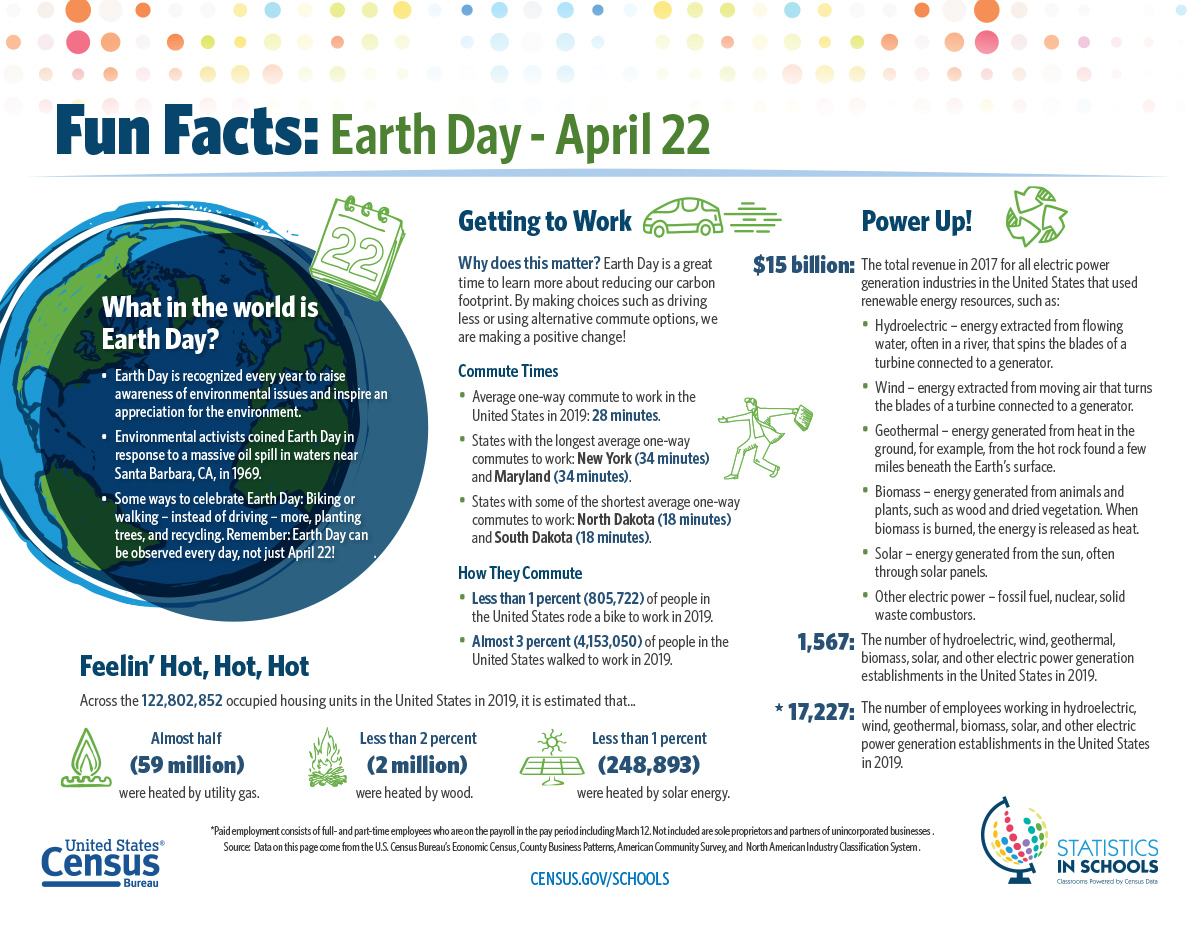
Earth Day is recognized every year to raise awareness of environmental issues and inspire an
appreciation for the world around us. Environmental activists coined Earth Day in
response to a massive oil spill in waters near Santa Barbara, Calif., in 1969.
See more Fun Facts in the graphic above or download the PDF from the U.S. Census Bureau.
April 11, 2022
TAX DAY
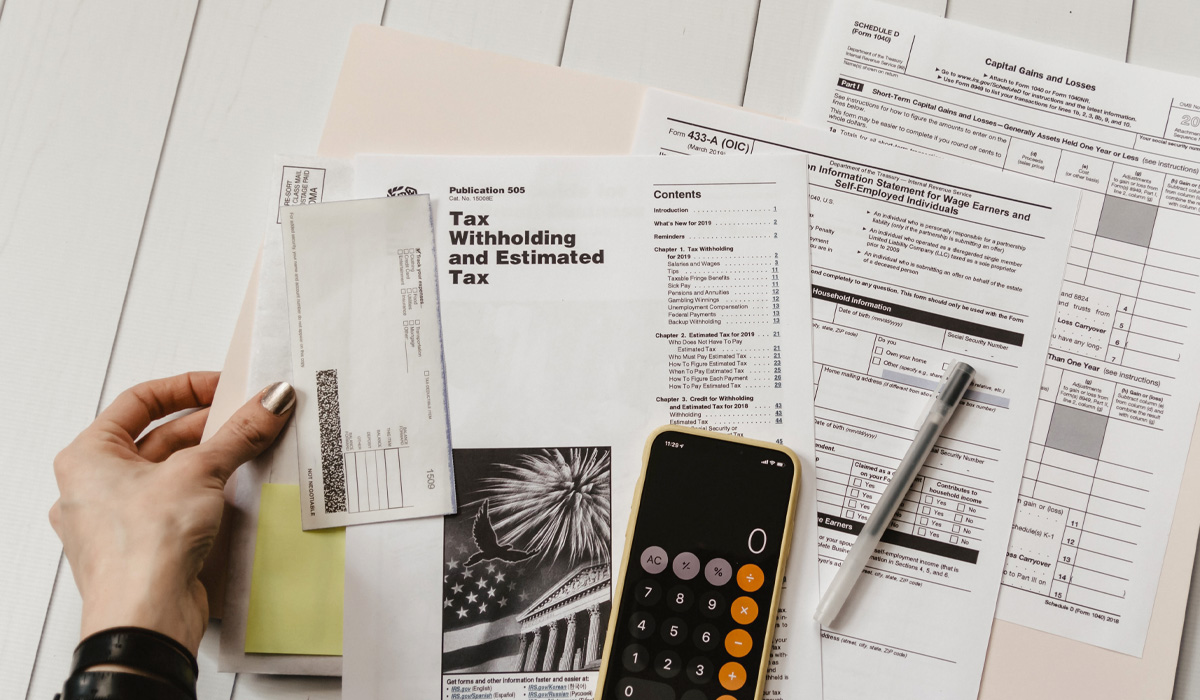
The history of the U.S. Income Tax Day
Ben Franklin wrote in 1789:
"In this world nothing can be said to be certain, except death and taxes."
For many, Tax Day is a reminder that we may need to work on the domain of financial wellness. Later
this month, we will list some tips and resources for achieving personal economic health
but this week, we’ll see how April 15 came to be the U.S. Income Tax Day, courtesy of the historians at the Library of Congress:
“The origin of the income tax on individuals is generally cited as the passage of
the 16th Amendment, passed by Congress on July 2, 1909, and ratified February 3, 1913.
However, its history actually goes back even further. During the Civil War, Congress
passed the Revenue Act of 1861, which included a tax on personal incomes to help pay
war expenses but the tax was repealed ten years later. However, in 1894 Congress enacted
a flat rate Federal income tax, which was ruled unconstitutional the following year
by the U.S. Supreme Court because it was a direct tax not apportioned according to
the population of each state. The 16th amendment, ratified in 1913, removed this objection
by allowing the Federal government to tax the income of individuals without regard
to the population of each state.
"April 15th has not always been the filing deadline. March 1st was the date specified
by Congress in 1913, after the passage of the 16th amendment. In 1918, Congress set
the date to March 15th, where it remained until the tax overhaul of 1954, when the
date was again moved to April 15th.”
Tax Day will be recognized in the U.S. this year on Monday, April 18, because the
Internal Revenue Service’s District of Columbia offices will be closed on April 15
in observance of the locally recognized Emancipation Day.
April 4, 2022
SOCIAL WELLNESS
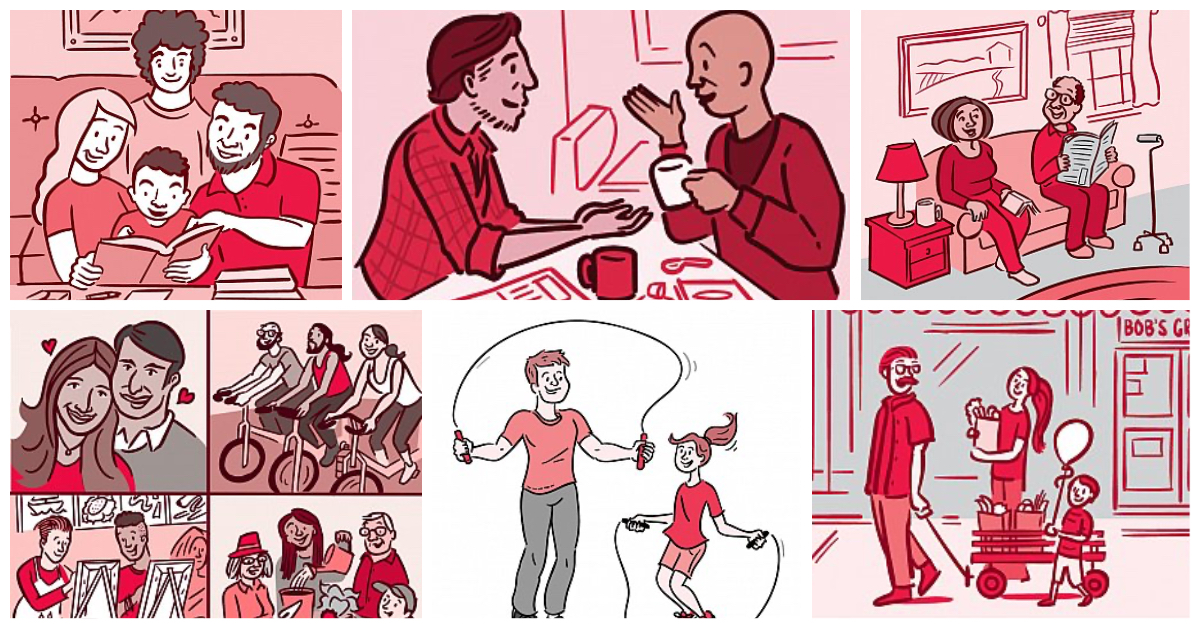
Positive social habits can help you build support systems and stay healthier mentally and physically. Check out the social wellness toolkit from the NIH.
March 28, 2022
ENVIRONMENTAL WELLNESS
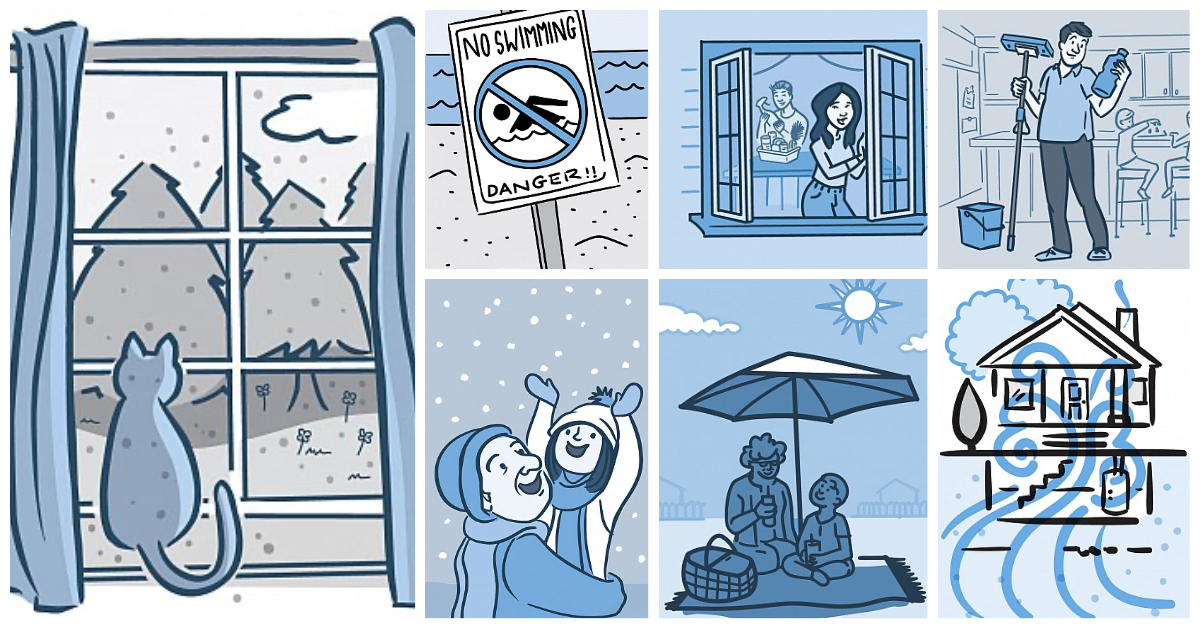
Our environment – both indoors and outdoors – can affect our health and wellness. Check out the environmental wellness toolkit from the NIH for ways to make the environments that you work and play in safer and healthier.
March 21, 2022
SPIRITUAL WELLNESS
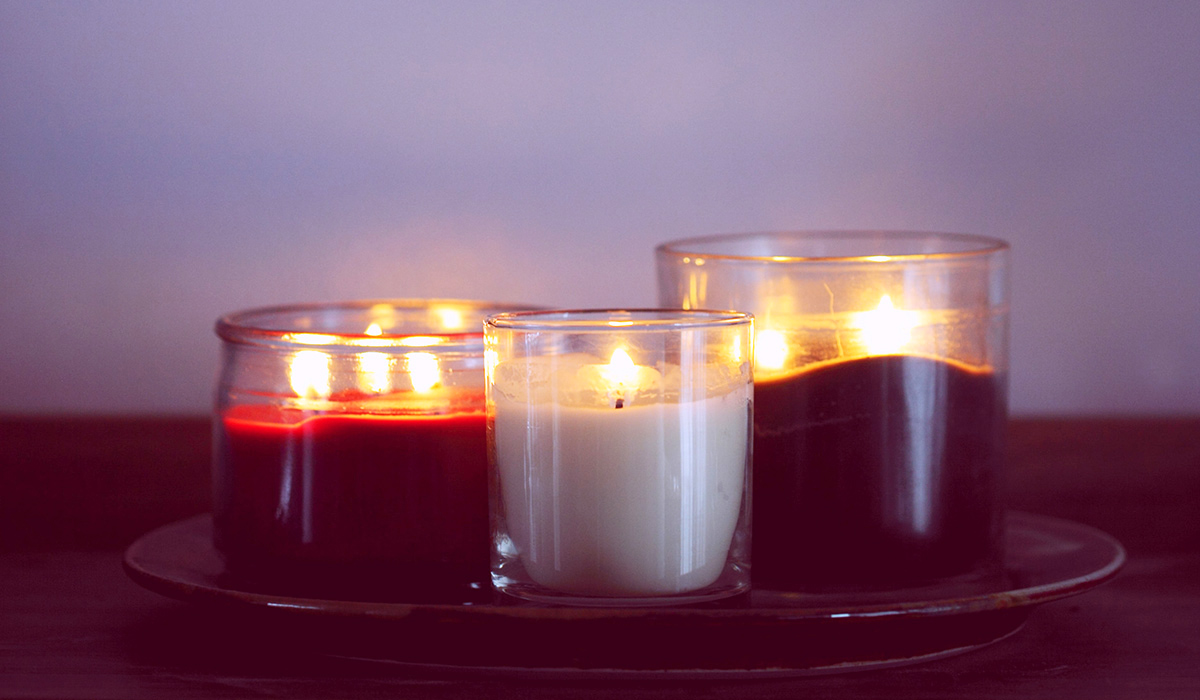
“Just as a candle cannot burn without fire, men cannot live without a spiritual life.” —Buddha
Spirituality and spiritual wellness are an integral part of overall health. Spiritual
wellness can be thought of as the pursuit of purpose and meaning in life, and the
development of an inner moral compass. For some people, this is related to religion
– for others, it is not.
Some suggestions for pursuing spiritual wellness include the following:
- Explore your personal values
- Question and clarify your values
- Become aware of how values develop and change from life experiences
- Become aware of the differences in others’ values
- Search for meaning in your own life
- Develop integrity by acting in ways that are consistent with your values
- Explore the issues related to mortality and your own life and death
“The privilege of a lifetime is to become who you really are.” —Carl Jung
March 14, 2022
ST. PATRICK’S DAY AND IRISH-AMERICAN HERITAGE MONTH
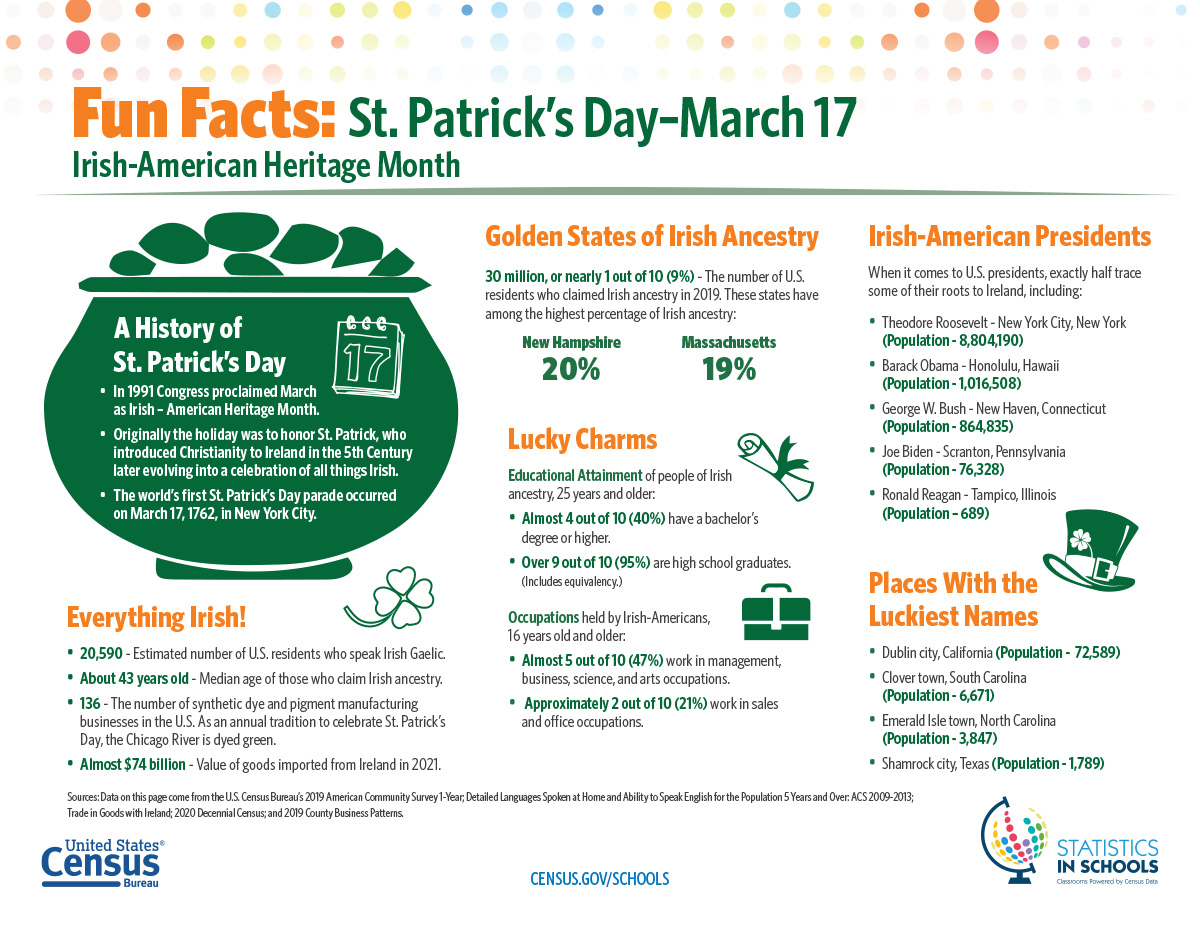
Happy St. Patrick’s Day!
The following fun facts for this holiday are brought to you from the U.S. Census Bureau.
March 7, 2022
INTELLECTUAL WELLNESS

Intellectual wellness refers to obtaining and maintaining optimal cognition — it’s often characterized by creativity, curiosity, and life-long learning.
But it’s more than keeping our brains young or bumping up our vocabulary; it’s the
ability — and desire — to learn new skills, hobbies, and ideas regardless of age.
Here’s some tips on improving intellectual wellness from our own Rocket Wellness:
- Instead of sitting down and watching television at the end of the day, opt for a good book or podcast instead. Toledo’s system of public libraries is one of the best in the state, so go out and
take advantage of it! Podcasts are also excellent ways to learn about new topics you
may be interested in.
- Learn a new skill. Is there a skill that immediately came to mind when you read this? Now is the time
to go out and learn it. Whether it’s cooking, gardening, crafting or building, learning
a new skill is a fun and interactive way to improve your intellectual intelligence.
- Play a board game. Strategy board games are all the rage currently, making board games both fun and
intellectually challenging. Some of our favorites include Clue, Risk, Settlers of
Catan and Pandemic. Try your hand at these to improve your critical thinking skills.
- Do a daily word search, crossword puzzle, or sudoku to enhance your intellectual wellness. These are easy activities which keep the mind
engaged and entertained simultaneously. Check out the links under the Intellectual
Wellness tab for some free activities.
- Improve your time management skills. Poor time management can lead to increased stress, which hinders every aspect of the Wellness Dimensions. Staying organized and on track allows your mind to work more efficiently and effectively.
February 28,2022
OCCUPATIONAL WELLNESS

Did you know that the average American will spend approximately one-third of their life at work?
When you figure in that the average American also spends about one-third of their
life sleeping and then the last third doing all the other “stuff” of life, it should
come as no surprise that occupational wellness usually includes not only career issues, but also the ability to balance leisure
time (time not at work) and personal health (of which good sleep is a huge part).
While there is no standardized definition of occupational wellness, the American Psychological Association states that it “includes job satisfaction, the ability to use one’s talents and skills
at work, and ambitions for professional growth and change. People with good occupational
wellness find their work rewarding, have good relationships with co-workers, and find
positive ways to handle workplace stress, all while also finding a good work-life
balance.”
And now enter the COVID pandemic – what will work-life balance and occupational wellness
look like in the future? While we can’t see what the work-place of the future looks
like, a recent article from the Harvard Business Review ends with the following thought-provoking observation:
“During this pandemic, employers are seeing that workers can’t function well without
accommodation for their family responsibilities. Will that lesson last after the crisis
is over? American families want greater choices in determining how their work and
their families fit together. Post-pandemic, can we create a system that fits real
workers, not just idealized ones? If so, we have the opportunity to emerge from this
crisis with both healthier employees and better performing organizations.”
February 21, 2022
EMOTIONAL WELLNESS
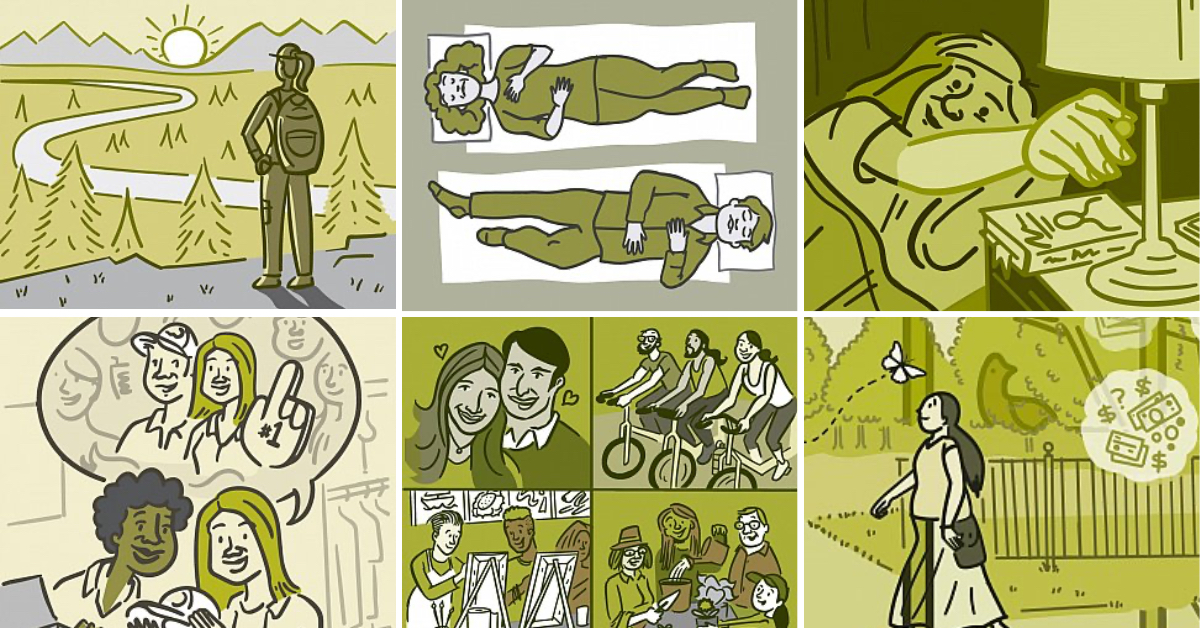
Here are some tips for improving emotional health from the NIH:
Brighten your outlook
Get quality sleep
Be mindful
Cope with loss
Strengthen social connections
February 14, 2022
HAPPY VALENTINE’S DAY!
Here are a few fun facts about the holiday courtesy of the U.S. Census Bureau.
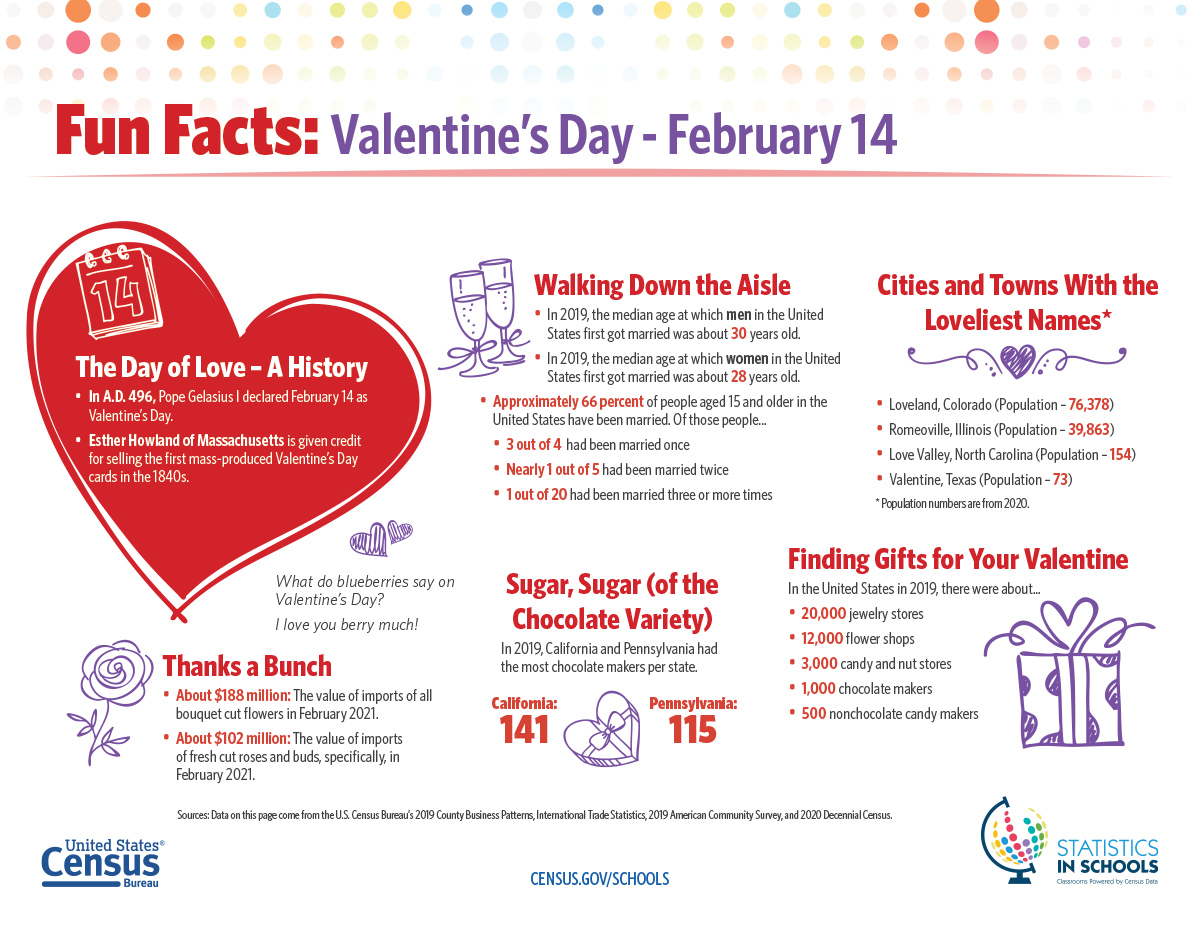
February 7, 2022
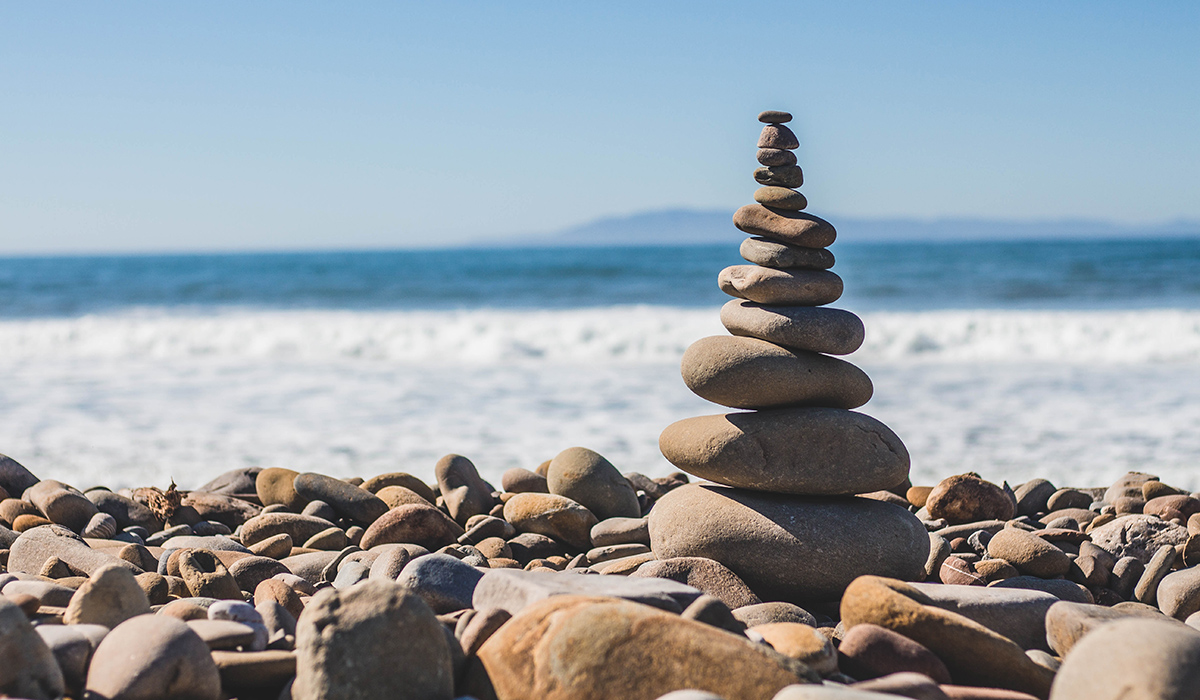
Ah, Serenity, Balance, and Inner Peace! In the noisy confusion of life, achieving a positive balance between the domains of wellness can help us to navigate the bumps and potholes encountered along life’s journey. While the Webster Dictionary defines serenity as “the state of being calm, peaceful, and untroubled,” here are some other ways to define serenity that may give a helpful perspective if you’re experiencing challenges in your life.
SERENITY IS:
- A way of life absorbed slowly and practiced one day at a time
- Perspective
- Becoming aware of and accepting my many characteristics and not judging what's "bad" or "good" but what's useful to keep and what to release
- A spiritual journey without a destination
- The space between impulse and the action
- Accepting what is
- Honoring my feelings without aiming them at someone else or letting them run my life
- A gift I choose to give myself
- Knowing that what works for me may change from moment to moment
- Understanding I may be powerless but I'm not hopeless
- Realizing my Higher Power does for me what I cannot do for myself
- Minding my own business
- The comfort of knowing I can hold my own hand
- Balance and relief from black and white thinking
- Understanding that reacting to life and responding to life are not the same thing
- Deliberate realignment with my Higher Power
- Feeling at peace with my past
- A matter of internal stability
- Becoming a complete being with my body and mind in one place at the same time
- Becoming one with my Higher Power
- Serenity opens my mind to new ideas
January 31, 2022
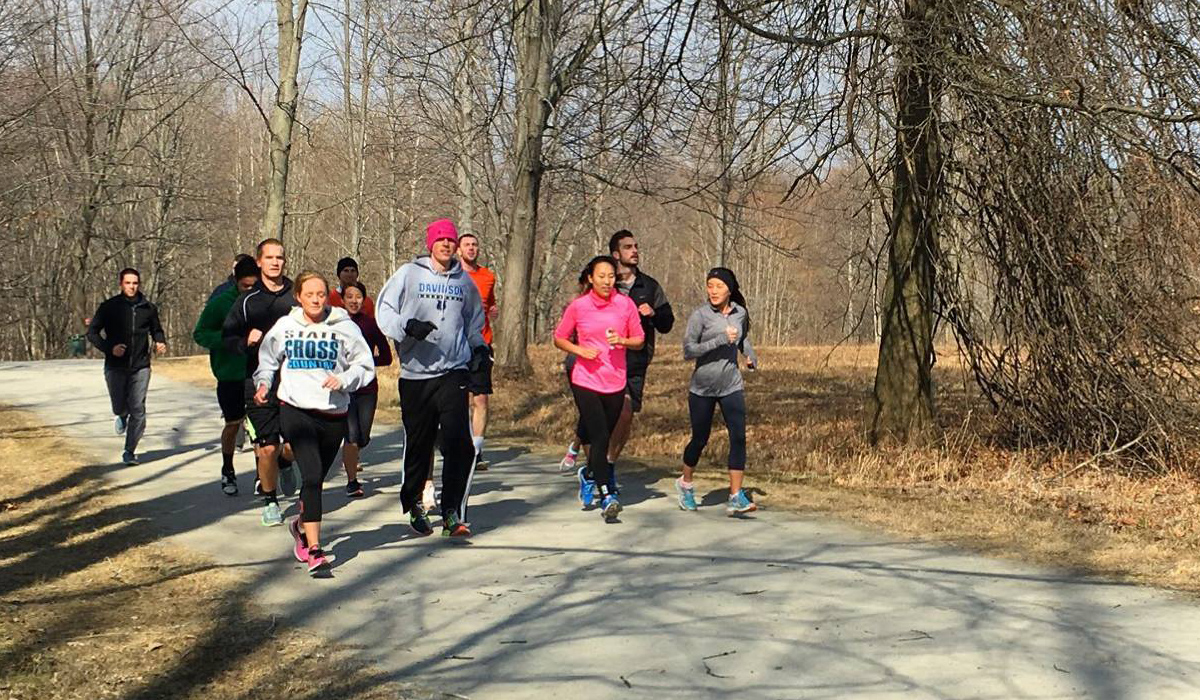
PHYSICAL WELLNESS – COLD-WEATHER EXERCISE
Exercise in cold weather presents unique challenges. While freezing temperatures should
not end outdoor work-out routines, it will require attention, planning, and caution
in order to stay safe and healthy. The following tips from the Mayo Clinic will help you get the most out of your winter exercise program:
Stay safe during cold-weather exercise
Exercise is safe for almost everyone, even in cold weather. But if you have certain
conditions, such as asthma, heart problems or Raynaud's disease, check with your doctor
first to review any special precautions you need based on your condition or your medications.
Check weather conditions and wind chill
Check the forecast before heading outside. Temperature, wind and moisture, along with
the length of time that you'll be outside, are key factors in planning a safe cold-weather
workout. The risk of frostbite is less than 5% when the air temperature is above 5°
F (minus 15° C), but the risk rises as the wind chill falls. At wind chill levels below minus 18° F (minus 28° C), frostbite can occur on exposed
skin in 30 minutes or less. Consider putting off your workout if it's raining or snowing unless you have waterproof
gear. Getting wet makes you more vulnerable to the cold. And if you get soaked, you
may not be able to keep your core body temperature high enough.
Know the signs of frostbite and hypothermia
Frostbite is most common on exposed skin, such as your cheeks, nose and ears. It can
also occur on hands and feet. Early warning signs include numbness, loss of feeling
or a stinging sensation. Immediately get out of the cold if you suspect frostbite. Slowly warm the affected area — but don't rub it because that can damage your skin.
Seek emergency care if numbness doesn't go away.
Hypothermia is abnormally low body temperature. When exposed to cold temperatures,
your body begins to lose heat faster than it can be produced. Exercising in cold, rainy weather increases the risk of hypothermia. Older adults and young children are at greater risk. Hypothermia signs and symptoms
include: intense shivering, slurred speech, loss of coordination, and fatigue. Seek
emergency help right away for possible hypothermia.
Dress in layers
Dressing too warmly is a big mistake when exercising in cold weather. Dress in layers that you can remove as soon as you start to sweat and then put back
on as needed. First, put on a thin layer of synthetic material, such as polypropylene, which draws
sweat away from your body. Avoid cotton, which stays wet next to your skin. Next,
add a layer of fleece or wool for insulation. Top this with a waterproof, breathable
outer layer. Keep in mind that stop-and-go activities, such as mixing walking with
running, can make you more vulnerable to the cold if you repeatedly work up a sweat
and then get chilly.
Protect your head, hands, feet and ears
When it's cold, blood flow is concentrated in your body's core, leaving your head,
hands and feet vulnerable to frostbite. Wear a thin pair of glove liners made of a wicking material (such as polypropylene)
under a pair of heavier gloves or mittens lined with wool or fleece. Put on the mittens or gloves before your hands become cold and then remove the outer
pair when your hands get sweaty. Consider buying exercise shoes a half size or one
size larger than usual to allow for thick thermal socks or an extra pair of regular
socks. And don't forget a hat to protect your head or headband to protect your ears.
If it's very cold, consider wearing a scarf or ski mask to cover your face.
Don't forget safety gear and sunscreen
If it's dark when you exercise outside, wear reflective clothing. And if you ride
a bike, both headlights and taillights are a good idea. To stay steady on your feet,
choose footwear with enough traction to prevent falls, especially if it's icy or snowy. Wear
a helmet while skiing, snowboarding and snowmobiling. Consider using chemical heat packs to warm up your hands or feet, especially if you
have a tendency to have cold fingers and toes or if you have a condition such as Raynaud's
disease. It's as easy to get sunburned in winter as in summer — even more so if you're exercising
in the snow or at high altitudes. Wear a sunscreen that blocks both UVA and UVB rays
and a lip balm with sunscreen. Protect your eyes from snow and ice glare with dark
glasses or goggles.
Drink plenty of fluids
Don't forget about hydration, as it's just as important during cold weather as it is in the heat. Drink water or sports drinks before, during and after your workout, even if you're not really thirsty. You can become dehydrated in the cold from sweating, breathing, the drying power of the winter wind and increased urine production, but it may be harder to notice during cold weather.
January 24, 2022
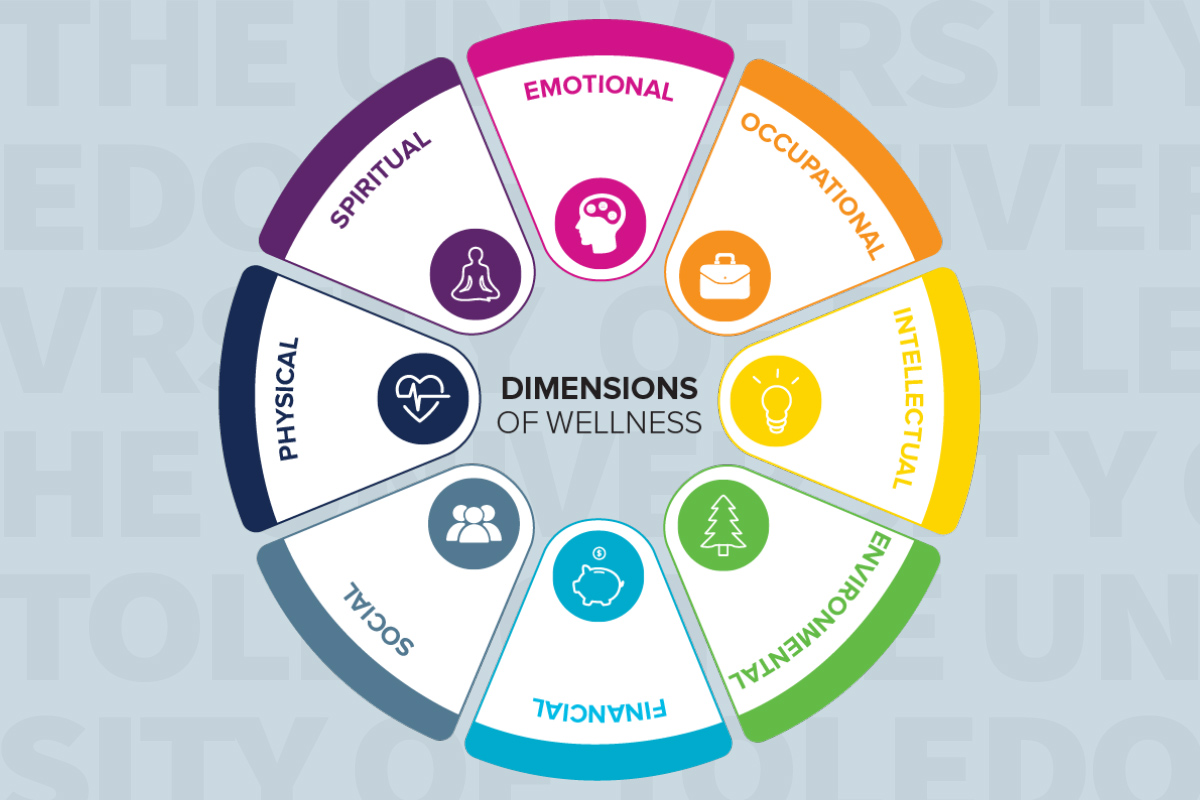
THE DIMENSIONS OF WELLNESS
Wellness doesn’t exist in a vacuum – there are both internal and external interconnected
dimensions ranging from personal physical health to financial health. And problems
or imbalances in one domain affect the health and balance of the other domains. Sometimes
it’s relatively obvious: financial problems can affect emotional or physical health.
Sometimes it’s less obvious: social isolation can lead to decreased intellectual wellness.
For this semester, we’ll look at these dimensions of wellness and share some tips and resources ranging from how to exercise safely in cold weather
to suggestions on celebrating Earth Day and environmental health.
January 17, 2022

MLK DAY
Dr. Martin Luther King Jr. was born on January 15, 1929 in Atlanta, Georgia and assassinated on April 4, 1968 in Memphis, Tennessee. He was an American Baptist minister and leader of the American Civil Rights Movement and received the Nobel Peace Prize in 1964 for "combating racial inequality through nonviolent resistance."
In honor of his work, MLK Day is observed on the third Monday of January. He is only the second U.S. citizen in
our nation’s history to have this honor bestowed upon them.
Dr. King delivered a number of famous speeches and sermons (such as "I've been to
the Mountaintop." and "Our God is Marching On"). But on August 28, 1963, Dr. King
delivered a landmark speech about civil rights in the United States that is recognized
world-wide as one of the most powerful calls for equality ever spoken. Take a moment to read and listen to his "I Have A Dream" speech in its entirety.
January 10, 2022

WELCOME TO WELLNESS: HAPPY 2022!
If you’re like the estimated 40% of Americans who’ve made one or more New Year’s resolutions,
you know it can be challenging to keep these even during normal times — and even more
so in the middle of a global pandemic! Here are some tips from the American Psychological Association to help you make your New Years' resolutions stick:
Start small
Make resolutions that you think you can keep. If, for example, your aim is to exercise
more frequently, schedule three or four days a week at the gym instead of seven. If
you would like to eat healthier, try replacing dessert with something else you enjoy,
like fruit or yogurt, instead of seeing your diet as a form of punishment.
Change one behavior at a time
Unhealthy behaviors develop over the course of time. Thus, replacing unhealthy behaviors
with healthy ones requires time. Don’t get overwhelmed and think that you have to
reassess everything in your life. Instead, work toward changing one thing at a time.
Talk about it
Share your experiences with family and friends. Consider joining a support group to
reach your goals, such as a workout class at your gym or a group of coworkers quitting
smoking. Having someone to share your struggles and successes with makes your journey
to a healthier lifestyle that much easier and less intimidating.
Don’t beat yourself up
Perfection is unattainable. Remember that minor missteps when reaching your goals
are completely normal and OK. Don’t give up completely because you ate a brownie and
broke your diet, or skipped the gym for a week because you were busy. Everyone has
ups and downs; resolve to recover from your mistakes and get back on track.
Ask for support
Accepting help from those who care about you and will listen strengthens your resilience and ability to manage stress caused by your resolution. If you feel overwhelmed or unable to meet your goals on your own, consider seeking professional help. Psychologists are uniquely trained to understand the connection between the mind and body. They can offer strategies as to how to adjust your goals so that they are attainable, as well as help you change unhealthy behaviors and address emotional issues.
December 20, 2021

Stay safe and healthy and see you next year!
Visit our website to learn more about staying well this holiday season.
December 13, 2021

Staying healthy during the holidays
The following CDC recommendations from pre-Covid on how to stay healthy and safe during the holiday season are good advice anytime:
- Wash hands often to help prevent the spread of germs. It’s flu season. Wash your hands with soap and clean running water for at least 20
seconds.
- Bundle up to stay dry and warm. Wear appropriate outdoor clothing: light, warm layers, gloves, hats, scarves, and
waterproof boots.
- Manage stress. Give yourself a break if you feel stressed out, overwhelmed, and out of control.
Some of the best ways to manage stress are to find support, connect socially, and
get plenty of sleep.
- Don’t drink and drive or let others drink and drive. Whenever anyone drives drunk, they put everyone on the road in danger. Choose not
to drink and drive and help others do the same.
- Be smoke-free. Avoid smoking and secondhand smoke. Smokers have greater health risks because of
their tobacco use, but nonsmokers also are at risk when exposed to tobacco smoke.
- Fasten seat belts while driving or riding in a motor vehicle. Always buckle your children in the car using a child safety seat, booster seat, or
seat belt according to their height, weight, and age. Buckle up every time, no matter
how short the trip and encourage passengers to do the same.
- Get exams and screenings. Ask your healthcare provider what exams you need and when to get them. Update your
personal and family history.
- Get your vaccinations. Vaccinations help prevent diseases and save lives. Everyone 6 months and older should
get a flu vaccine each year.
- Monitor children. Keep potentially dangerous toys, food, drinks, household items, and other objects
out of children’s reach. Protect them from drowning, burns, falls, and other potential
accidents.
- Practice fire safety. Most residential fires occur during the winter months, so don’t leave fireplaces,
space heaters, food cooking on stoves, or candles unattended. Have an emergency plan
and practice it regularly.
- Prepare food safely. Remember these simple steps: Wash hands and surfaces often, avoid cross-contamination,
cook foods to proper temperatures and refrigerate foods promptly.
- Eat healthy, stay active. Eat fruits and vegetables which pack nutrients and help lower the risk for certain diseases. Limit your portion sizes and foods high in fat, salt, and sugar. Also, be active for at least 2½ hours a week and help kids and teens be active for at least 1 hour a day.
Stay well this holiday season!
December 6, 2021

Eating healthy during the holidays
You’ve been working on your personal wellness journey this year. You’ve been exercising
regularly, sleeping better, and feeling healthier. Then along comes the holiday buffet
table minefield, complete with your aunt’s famous pecan pie and your brother’s spiked
eggnog!
The following tips from Patrick Skerrett at Harvard Medical School may help you eat better and healthier this holiday season:
- Budget wisely. Don’t eat everything at feasts and parties. Be choosy and spend calories judiciously
on the foods you love.
- Take 10 before taking seconds. It takes a few minutes for your stomach’s "I’m getting full" signal to get to your
brain. After finishing your first helping, take a 10-minute break. Make conversation.
Drink some water. Then recheck your appetite. You might realize you are full or want
only a small portion of seconds.
- Distance helps the heart stay healthy. At a party, don’t stand next to the food table. That makes it harder to mindlessly
reach for food as you talk. If you know you are prone to recreational eating, pop
a mint or a stick of gum so you won’t keep reaching for the chips.
- Don’t go out with an empty tank. Before setting out for a party, eat something so you don’t arrive famished. Excellent
pre-party snacks combine complex carbohydrates with protein and unsaturated fat, like
apple slices with peanut butter or a slice of turkey and cheese on whole-wheat pita
bread.
- Drink to your health. A glass of eggnog can set you back 500 calories; wine, beer, and mixed drinks range
from 150 to 225 calories. If you drink alcohol, have a glass of water or juice-flavored
seltzer in between drinks.
- Avoid alcohol on an empty stomach. Alcohol increases your appetite and diminishes your ability to control what you eat.
- Put on your dancing (or walking) shoes. Dancing is a great way to work off some holiday calories. If you are at a family gathering,
suggest a walk before the feast or even between dinner and dessert.
- Make room for veggies. At meals and parties, don’t ignore fruits and vegetables. They make great snacks and
even better side or main dishes — unless they’re slathered with creamy sauces or butter.
- Be buffet savvy. At a buffet, wander ’round the food table before putting anything on your plate. By
checking out all of your options, you might be less inclined to pile on items one
after another.
- Don’t shop hungry. Eat before you go shopping so the scent of Cinnabons or caramel corn doesn’t tempt
you to gobble treats you don’t need.
- Cook from (and for) the heart. To show family and friends that you really care about them, be creative with recipes that use less butter, cream, lard, vegetable
shortening, and other ingredients rich in saturated fats. Prepare turkey or fish instead of red meat.
- Pay attention to what really matters. Although food is an integral part of the holidays, put the focus on family and friends, laughter and cheer. If balance and moderation are your usual guides, it’s okay to indulge or overeat once in a while.
Stay well this holiday season!
November 29, 2021

The Holidays are here!
The holiday season is upon us. We may have missed out on seeing family and friends
during the pandemic, leading this year to even higher expectations and potential overcommitment.
And that can be a recipe for disaster. There are ways to prepare for the holiday that
includes a gift to yourself – mental health and wellness!
Here are a few tips to have a happy, healthy holiday this year.
- Plan your holiday events thoughtfully. For most of us, we race through the holidays like we are strapped to the tip of a
rocket. Not a good idea. Protect your mental health by limiting alcohol, getting adequate
sleep, and limiting stress – and understanding the emotional complexities of holiday
expectations. Your dinner table does NOT need to look like a Norman Rockwell Masterpiece.
Your second cousin once removed does NOT need to have the absolutely totally most-unbelievably-perfect
gift – i.e., the GOAT of gifts — at the extended family gift exchange.
- Ah, Family: Speaking of family, for some people, holidays and family events are potential minefields
of the emotions. If you find yourself in that category, here are few tips that may
help you survive and even thrive:
- Remember the old expression, "You don’t have to attend every fight you’re invited to."
- Here are three phrases to remember that may come in handy when you’re thinking about
strapping yourself on to an emotional rollercoaster ride:
- You may be right
- Let me think about that
- No (No is a complete sentence)
- Here are three phrases to remember that may come in handy when you’re thinking about
strapping yourself on to an emotional rollercoaster ride:
- If you know you will be encountering difficult people, have an escape plan:
- For example, it’s ok to leave an event to take a nap or go to bed early – you’ll be
the envy of everyone over age 35!
- For example, it’s ok to leave an event to take a nap or go to bed early – you’ll be
the envy of everyone over age 35!
- The holidays offer a time for personal reflection and a focus on gratitude and joy.
And the most important factor will be your attitude. Disappointments – resentments
– ancient battles of bygone years – these will sap your strength and leave you with
nothing. Remember the words of Abraham Lincoln: "Most folks are about as happy as they make up their minds to be."
- Remember the old expression, "You don’t have to attend every fight you’re invited to."
- Finally, don’t forget your self-care! That is truly the gift that keeps on giving.
Stay well this holiday season!
November 22, 2021
THANKFULNESS
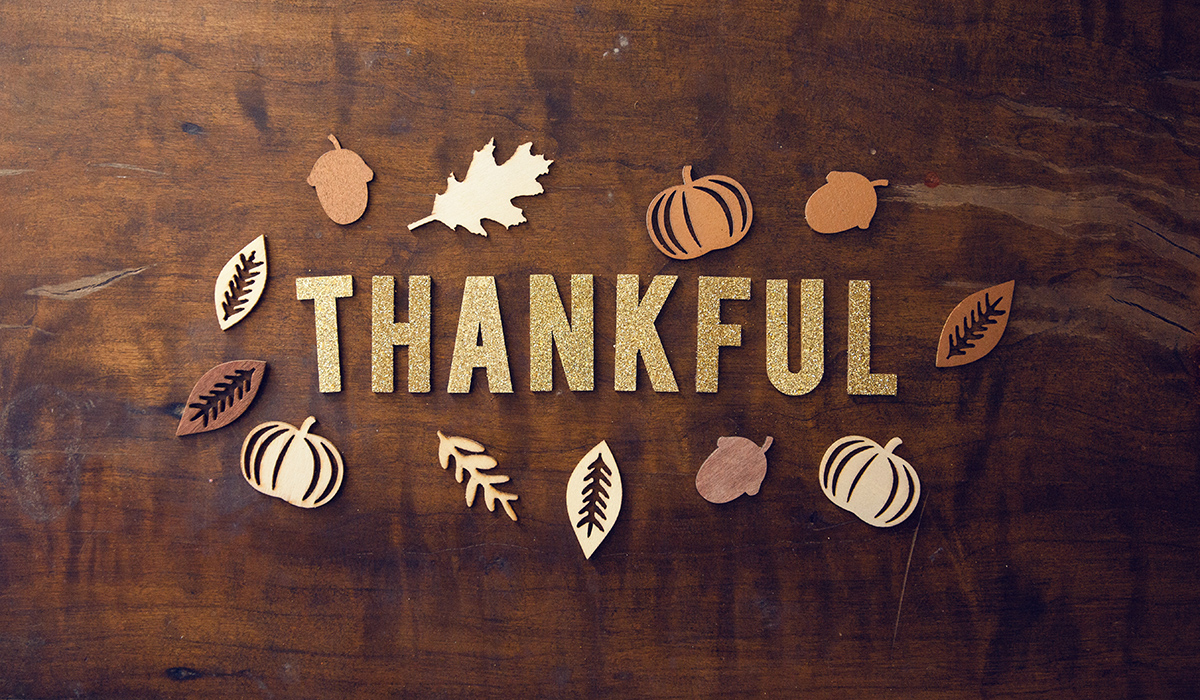
Many countries set aside a day for gratitude and thanks, usually occurring after the
fall harvest. In the U.S., Thanksgiving was officially declared a federal holiday in 1863 by President Abraham
Lincoln – and consider, for a moment, the setting in which this occurred. The American Civil
War at that time was entering its second year and the outcome was still uncertain.
The Battle of Gettysburg had been won four months earlier and the tide was turning
but the conflict was far from over. On a personal note, Lincoln had lost his second
son (and third child), Willie, in 1862 and the strains were aging him rapidly. And
in the middle of that, he set aside a national day for gratitude – and that is something
we can all be thankful for!
A Proclamation by President Abraham Lincoln
The year that is drawing towards its close, has been filled with the blessings of
fruitful fields and healthful skies. To these bounties, which are so constantly enjoyed
that we are prone to forget the source from which they come, others have been added,
which are of so extraordinary a nature, that they cannot fail to penetrate and soften
even the heart which is habitually insensible to the ever watchful providence of Almighty
God.
In the midst of a civil war of unequalled magnitude and severity, which has sometimes
seemed to foreign States to invite and to provoke their aggression, peace has been
preserved with all nations, order has been maintained, the laws have been respected
and obeyed, and harmony has prevailed everywhere except in the theatre of military
conflict; while that theatre has been greatly contracted by the advancing armies and
navies of the Union.
Needful diversions of wealth and of strength from the fields of peaceful industry
to the national defence, have not arrested the plough, the shuttle or the ship; the
axe has enlarged the borders of our settlements, and the mines, as well of iron and
coal as of the precious metals, have yielded even more abundantly than heretofore.
Population has steadily increased, notwithstanding the waste that has been made in
the camp, the siege and the battle-field; and the country, rejoicing in the consciousness
of augmented strength and vigor, is permitted to expect continuance of years with
large increase of freedom. No human counsel hath devised nor hath any mortal hand
worked out these great things. They are the gracious gifts of the Most High God, who,
while dealing with us in anger for our sins, hath nevertheless remembered mercy.
It has seemed to me fit and proper that they should be solemnly, reverently and gratefully
acknowledged as with one heart and one voice by the whole American People. I do therefore
invite my fellow citizens in every part of the United States, and also those who are
at sea and those who are sojourning in foreign lands, to set apart and observe the
last Thursday of November next, as a day of Thanksgiving and Praise to our beneficent
Father who dwelleth in the Heavens. And I recommend to them that while offering up
the ascriptions justly due to Him for such singular deliverances and blessings, they
do also, with humble penitence for our national perverseness and disobedience, commend
to His tender care all those who have become widows, orphans, mourners or sufferers
in the lamentable civil strife in which we are unavoidably engaged, and fervently
implore the interposition of the Almighty Hand to heal the wounds of the nation and
to restore it as soon as may be consistent with the Divine purposes to the full enjoyment
of peace, harmony, tranquillity and Union.
In testimony whereof, I have hereunto set my hand and caused the Seal of the United
States to be affixed.
Done at the City of Washington, this Third day of October, in the year of our Lord
one thousand eight hundred and sixty-three, and of the Independence of the United
States the Eighty-eighth.
By the President: Abraham Lincoln
November 17, 2021
Resiliency: Part 3
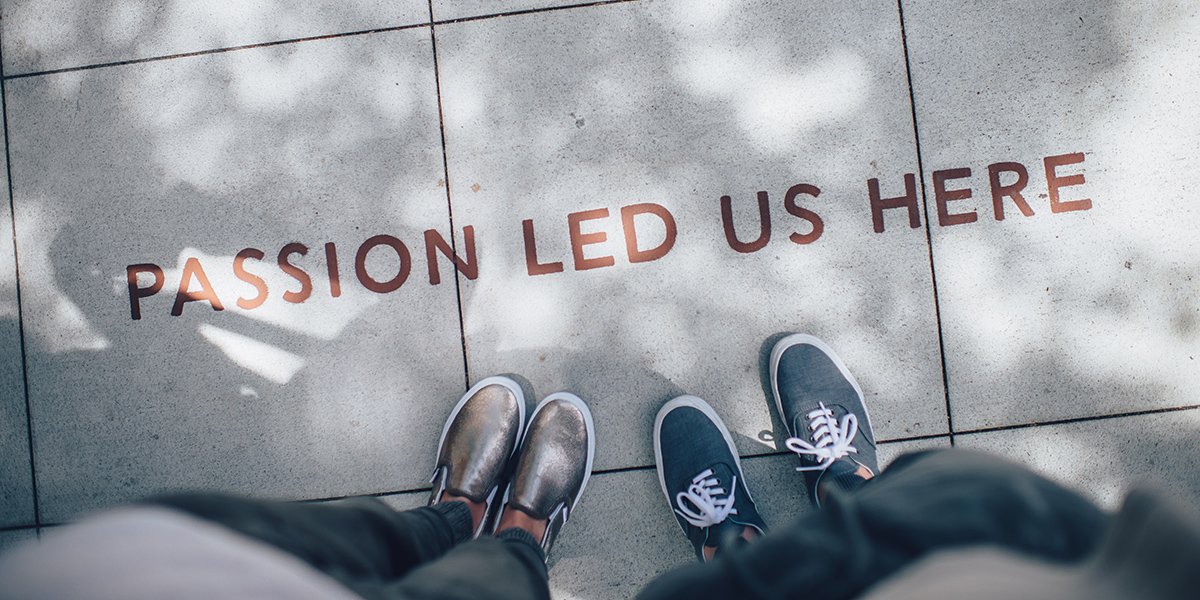
A focus on healthy thinking and meaning from the American Psychological Association:
Find purpose
Help others. Whether you volunteer with a local homeless shelter or simply support a friend in
their own time of need, you can garner a sense of purpose, foster self-worth, connect
with other people, and tangibly help others, all of which can empower you to grow
in resilience.
Be proactive. It’s helpful to acknowledge and accept your emotions during hard times, but it’s
also important to help you foster self-discovery by asking yourself, “What can I do
about a problem in my life?” If the problems seem too big to tackle, break them down
into manageable pieces. Taking initiative will remind you that you can muster motivation
and purpose even during stressful periods of your life, increasing the likelihood
that you’ll rise up during painful times again.
Move toward your goals. Develop some realistic goals and do something regularly — even if it seems like a
small accomplishment — that enables you to move toward the things you want to accomplish.
Instead of focusing on tasks that seem unachievable, ask yourself, “What’s one thing
I know I can accomplish today that helps me move in the direction I want to go?” For
example, if you’re struggling with the loss of a loved one and you want to move forward,
you could join a grief support group in your area.
Look for opportunities for self-discovery. People often find that they have grown in some respect as a result of a struggle.
For example, after a tragedy or hardship, people have reported better relationships
and a greater sense of strength, even while feeling vulnerable. That can increase
their sense of self-worth and heighten their appreciation for life.
Embrace healthy thoughts
Keep things in perspective. How you think can play a significant part in how you feel — and how resilient you
are when faced with obstacles. Try to identify areas of irrational thinking, such
as a tendency to catastrophize difficulties or assume the world is out to get you,
and adopt a more balanced and realistic thinking pattern. For instance, if you feel
overwhelmed by a challenge, remind yourself that what happened to you isn’t an indicator
of how your future will go, and that you’re not helpless. You may not be able to change
a highly stressful event, but you can change how you interpret and respond to it.
Accept change. Accept that change is a part of life. Certain goals or ideals may no longer be attainable
as a result of adverse situations in your life. Accepting circumstances that cannot
be changed can help you focus on circumstances that you can alter.
Maintain a hopeful outlook. It’s hard to be positive when life isn’t going your way. An optimistic outlook empowers
you to expect that good things will happen to you. Try visualizing what you want,
rather than worrying about what you fear. Along the way, note any subtle ways in which
you start to feel better as you deal with difficult situations.
Learn from your past. By looking back at who or what was helpful in previous times of distress, you may
discover how you can respond effectively to new difficult situations. Remind yourself
of where you’ve been able to find strength and ask yourself what you’ve learned from
those experiences.
November 8, 2021
Resiliency: Part 2
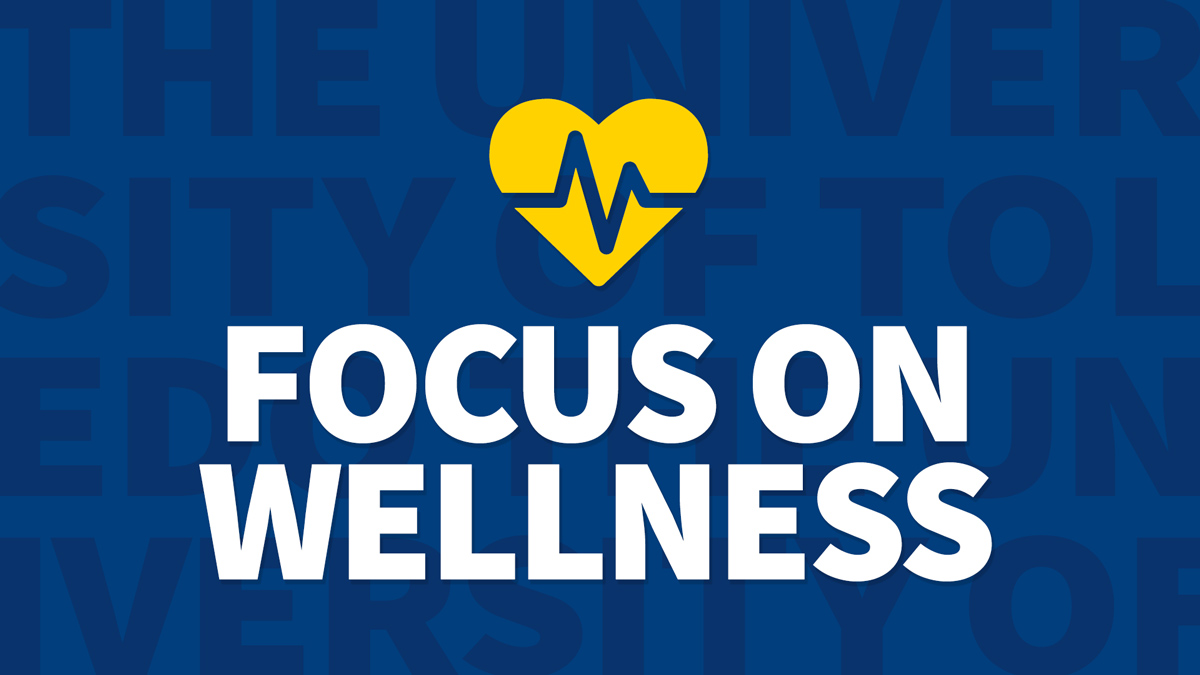
Build your connections
Prioritize relationships. Connecting with empathetic and understanding people can remind you that you’re not
alone in the midst of difficulties. Focus on finding trustworthy and compassionate
individuals who validate your feelings, which will support the skill of resilience.
The pain of traumatic events can lead some people to isolate themselves, but it’s
important to accept help and support from those who care about you. Whether you go
on a weekly date night with your spouse or plan a lunch out with a friend, try to
prioritize genuinely connecting with people who care about you.
Join a group. Along with one-on-one relationships, some people find that being active in civic groups,
faith-based communities, or other local organizations provides social support and
can help you reclaim hope. Research groups in your area that could offer you support
and a sense of purpose or joy when you need it.
Foster wellness
Take care of your body. Self-care may be a popular buzzword, but it’s also a legitimate practice for mental
health and building resilience. That’s because stress is just as much physical as
it is emotional. Promoting positive lifestyle factors like proper nutrition, ample
sleep, hydration, and regular exercise can strengthen your body to adapt to stress
and reduce the toll of emotions like anxiety or depression.
Practice mindfulness. Mindful journaling, yoga, and other spiritual practices like prayer or meditation
can also help people build connections and restore hope, which can prime them to deal
with situations that require resilience. When you journal, meditate, or pray, ruminate
on positive aspects of your life and recall the things you’re grateful for, even during
personal trials.
Avoid negative outlets. It may be tempting to mask your pain with alcohol, drugs, or other substances, but
that’s like putting a bandage on a deep wound. Focus instead on giving your body resources
to manage stress, rather than seeking to eliminate the feeling of stress altogether.
November 1, 2021
Resiliency: Part 1

Shake it off – snap out of it – just bounce back.
These are some of the unhelpful and inaccurate phrases people often use when talking
about one of the most important aspects of general good health: psychological resilience. The American Psychological Association (APA) defines resilience as follows:
resilience
n. the process and outcome of successfully adapting to difficult or challenging life
experiences, especially through mental, emotional, and behavioral flexibility and
adjustment to external and internal demands. A number of factors contribute to how well people adapt to adversities, predominant
among them (a) the ways in which individuals view and engage with the world, (b) the
availability and quality of social resources, and (c) specific coping strategies.
Psychological research demonstrates that the resources and skills associated with
more positive adaptation (i.e., greater resilience) can be cultivated and practiced.
Also called psychological resilience.
The good news is that psychological resilience can be learned – and it can be strengthened
and improved over time. Is it easy to learn? Not always – in fact, "the road to resilience is likely to involve
considerable emotional distress. … Like building a muscle, increasing your resilience takes time and intentionality. Focusing on four core components — connection, wellness,
healthy thinking, and meaning — can empower you to withstand and learn from difficult
and traumatic experiences."
In the next two wellness articles, we will cover the APA segments on connection and
wellness first and then healthy thinking and meaning.
But finally, as noted by the American Psychological Association: "Getting help when you need it is crucial in building your resilience. … It is important to get professional help if you feel like you are unable to function
as well as you would like or perform basic activities of daily living as a result
of a traumatic or other stressful life experience. Keep in mind that different people
tend to be comfortable with different styles of interaction. To get the most out of
your therapeutic relationship, you should feel at ease with a mental health professional
or in a support group. The important thing is to remember you’re not alone on the journey. While you may not be able to control all of your circumstances, you can grow by focusing
on the aspects of life’s challenges you can manage with the support of loved ones
and trusted professionals."
October 25, 2021
Halloween Health: Part 2

Halloween is here! Listed below are some pumpkin carving tips from Consumer Reports.
1. Use the Right Tools
Instead of the knives in your kitchen, use the specialty tools in a pumpkin-carving
kit — readily found online and in convenience stores and designed for pumpkin carving
safety. The instruments are generally small, which makes them easier to control than
most knives and easier to use when making intricate cuts.
2. Carve Your Pumpkin With Its Top On
Hold the top of the pumpkin to stabilize it and cut with your carving instrument's
blade pointing down. Instead of removing the top of the pumpkin to scoop out the insides,
you could cut a hole in the bottom. If you're using a candle inside your pumpkin,
you can then place the carved pumpkin on top of the lit candle — rather than awkwardly
reaching inside the pumpkin to light the candle.
3. Keep Things Clean, Dry, and Bright
For pumpkin carving safety, work in a clean, dry, and well-lit area, keep your hands
and tools clean and dry, and take your time.
4. Don’t Let Kids Carve
Children 14 and younger should not do the actual carving. Instead, for pumpkin carving
safety, have them draw the pattern with a marker and clean out the pulp and seeds
with their hands or a spoon — but make sure an adult does the actual cutting. It’s
important to supervise older teens, too.
5. Know First Aid
If you or a family member gets cut while carving a pumpkin, apply direct pressure to the injury using a clean, dry cloth. If bleeding doesn't stop in 15 minutes, get to an emergency room or urgent-care clinic.
October 18, 2021
HALLOWEEN HEALTH: PART 1
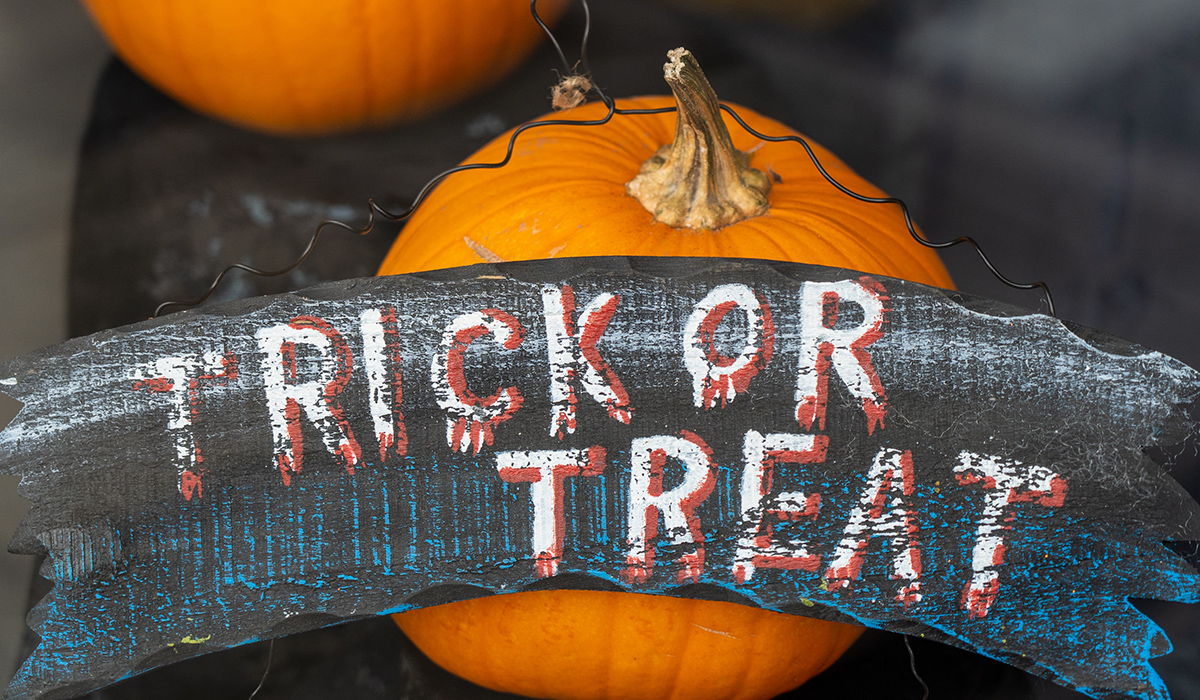
Halloween is just around the corner! The following tips on how to stay healthy during
trick-or-treating are brought to you courtesy of the Mayo Clinic.
To prepare for trick-or-treaters:
- Clean up. Put away tripping hazards, such as garden hoses, toys and bikes. Clear wet leaves, snow or other debris from the sidewalk.
- Turn the lights on. Replace burned-out bulbs to ensure visibility at the walkway and front door.
- Control your pets. Take no chances that your pet might be frightened and chase or bite a child at your door.
- Consider sugar substitutes. Instead of handing out sweets, try stickers, fun pencils, rubber insects or colored chalk.
Choose costumes wisely:
- The brighter the better. Choose bright colors and flame-retardant materials. If your child will be outdoors after dark, attach reflective tape to his or her costume or treat bag.
- Size it right. If it's chilly outdoors, make sure your child's costume is loose enough for warm clothing to be worn underneath — but not long enough to cause tripping. Avoid oversized shoes and high heels.
- Skip the masks. A mask can obstruct your child's vision, especially if it slips out of place. Use nontoxic makeup instead.
- Limit accessories. Pointed props — such as wands, swords and knives — might pose safety hazards.
Carve safely:
- Consider alternatives to carving. Decorate with markers, glitter glue or paint. Let young children draw faces on pumpkins with art supplies. Leave carving to an adult.
- Use candles with care. Place candlelit pumpkins on a sturdy surface away from curtains and other flammable objects. Never leave candlelit pumpkins unattended. Better yet, light pumpkins with flashlights, battery-operated flameless candles or glow sticks instead.
October 11, 2021
STAYING HEALTHY THIS FALL
The days are getting shorter – the nights are getting longer – and the leaves are starting their journey to the ground. Fall is here and the CDC has these 12 tips for staying healthy this fall.

October 4, 2021
GET YOUR FLU SHOT
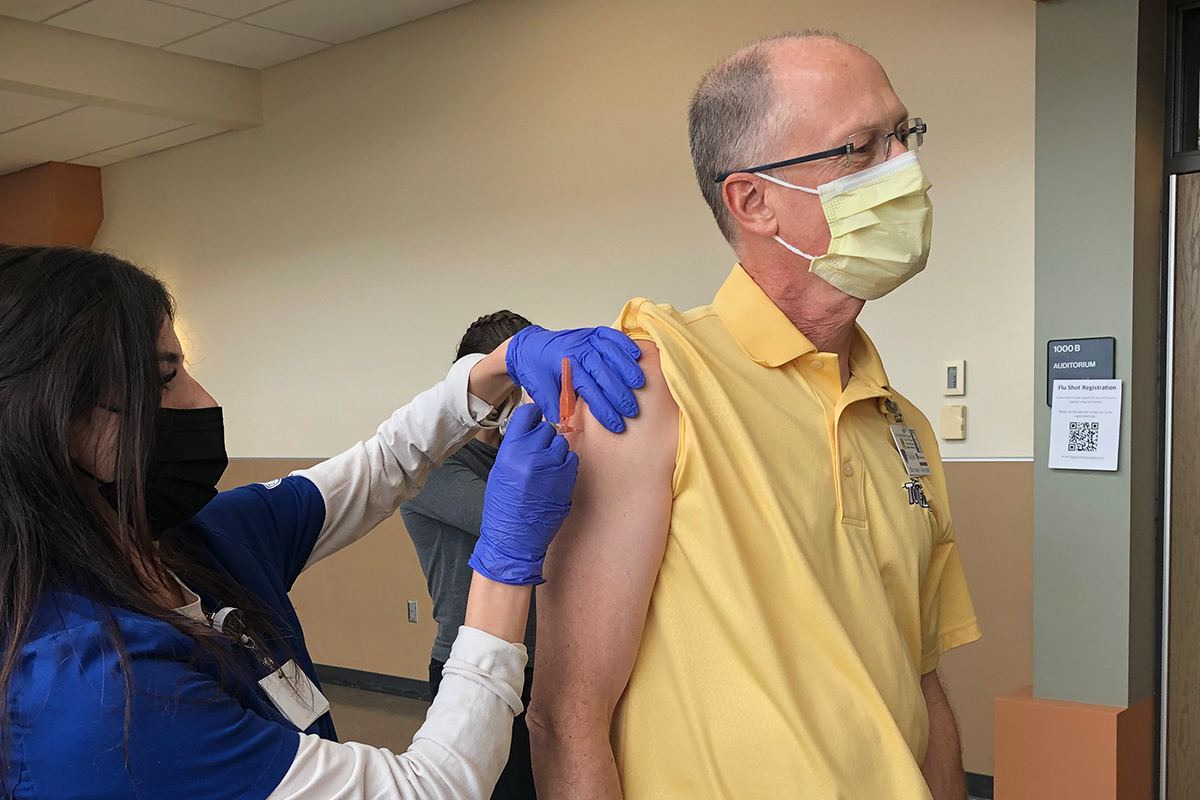
As part of its effort to promote a safe and healthy campus, The University of Toledo
is now requiring annual influenza vaccines for all on-campus students and many employees.
The new policy, which went into effect Sept. 14, requires employees who are not represented
by a bargaining unit to upload proof of vaccination by Dec. 1 of each year. Students,
both undergraduate and graduate, also must provide proof of vaccination against influenza
by Dec. 1.
Flu shots will be available for faculty, staff and students on the Health Science
Campus from 8 a.m. to noon Monday through Friday at the outpatient pharmacy in the
UTMC Medical Pavilion beginning Oct. 5.
The vaccines are free and appointments are not required, but individuals do need to
complete a consent form, available at influenza.utoledo.edu, prior to getting their flu shot.
Faculty, staff and students who complete a consent form and get vaccinated through
the University will have their proof of vaccination uploaded automatically. Those
who have received flu shots elsewhere need to upload proof of vaccination at utvaccinereg.utoledo.edu.
The U.S. Centers for Disease Control and Prevention estimates there have been between
9 million and 45 million influenza infections annually since 2010, resulting in 140,000
to 810,000 hospitalizations and 12,000 to 61,000 deaths each year.
Seasonal flu vaccines are recommended by the CDC for all Americans aged 6 months and
older.
September 27, 2021
SEASONAL AFFECTIVE DISORDER (SAD)
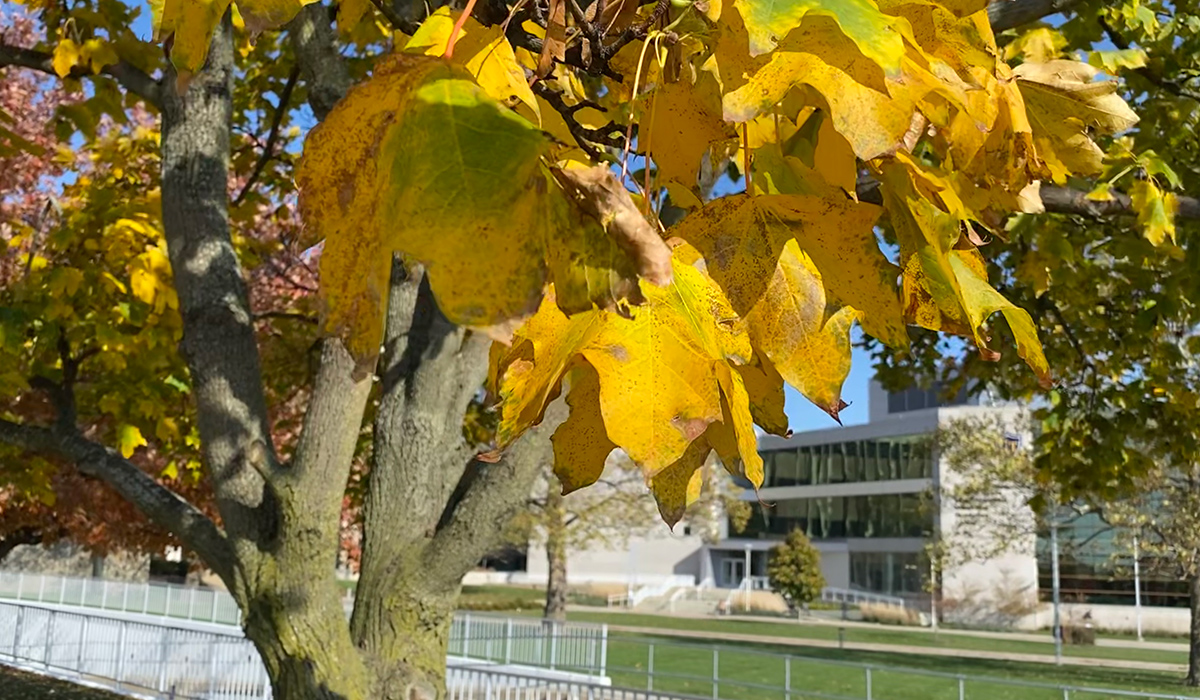
Wednesday, Sept. 22 is the Autumnal Equinox – the first official day of fall. In our part of the world, the nights are getting
longer and the days are getting shorter. In fact, we won’t have an equal amount of
daylight and night for another six months – until the Spring Equinox on March 20.
While circadian rhythms and seasonal changes affect all of our lives, some people
experience increasing alterations in their mood as the hours spent in night-mode lengthen.
SAD – seasonal affective disorder – usually begins in the fall and lasts into the
winter (although for some people, SAD symptoms begin in the spring and go away in
the fall). According to the mayoclinic.org, signs and symptoms of SAD begin and end
at about the same time each year and may include:
- Feeling depressed most of the day, nearly every day
- Losing interest in activities you once enjoyed
- Having low energy
- Having problems with sleeping
- Experiencing changes in your appetite or weight
- Feeling sluggish or agitated
- Having difficulty concentrating
- Feeling hopeless, worthless or guilty
- Having frequent thoughts of death or suicide
No one knows what causes SAD, but some of the risk factors include:
- Family history. People with SAD may be more likely to have blood relatives with SAD or another form of depression.
- Having major depression or bipolar disorder. Symptoms of depression may worsen seasonally if you have one of these conditions.
- Living far from the equator. SAD appears to be more common among people who live far north or south of the equator. This may be due to decreased sunlight during the winter and longer days during the summer months.
A diagnosis of SAD can only be made by a mental health professional. If you have any questions or concerns or just want to talk, please visit the Rocket Health website and reach out. We also have a number of resources on our Wellness website. The Employee Assistance Program (EAP) is also available for faculty and staff.
Finally, whether or not you have SAD, there are some helpful and healthy things you can do to help make you feel brighter inside even if it’s dark and cold outside:
- Make your environment sunnier and brighter. Open blinds, trim tree branches that block sunlight or add skylights to your home. Sit closer to bright windows while at home or in the office.
- Get outside. Take a long walk, eat lunch at a nearby park, or simply sit on a bench and soak up the sun. Even on cold or cloudy days, outdoor light can help — especially if you spend some time outside within two hours of getting up in the morning.
- Exercise regularly. Exercise and other types of physical activity help relieve stress and anxiety, both of which can increase SAD symptoms. Being more fit can make you feel better about yourself, too, which can lift your mood.
September 13, 2021
WELLNESS SURVEY RESULTS
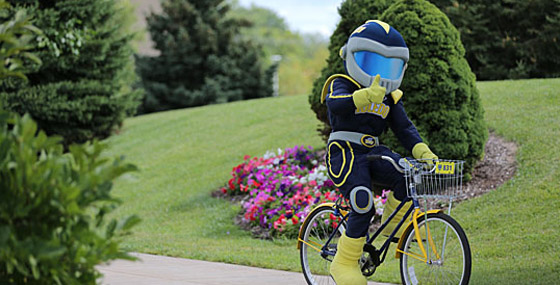
Thanks to everyone who completed the survey. Nearly 70 people responded – some of their ideas and insights are listed below:
- "I love the idea of wellness events that are coming up. My hope is that leadership encourages everyone to take this time and actually attend."
- "We need systemic changes to improve wellness, not only 'personal resilience.'"
- "Can't change the business of medicine. Wellness won't change until then."
A number of ideas and suggestions to improve wellness were also shared – these included:
- Encourage physical activity – make sure students, residents, faculty/staff have time to exercise, a place to exercise, and a reason (incentives) to exercise
- More access to mental health services
- More social events and events that encourage community and team building
- Host activities (cooking classes, ice skating, arts and crafts!)
- Free gym memberships
As we continue our wellness journey throughout this year, we will try to incorporate
these suggestions into the events that are offered – and thank you again for your
input!
September 7, 2021
WHAT WOULD YOU DO?
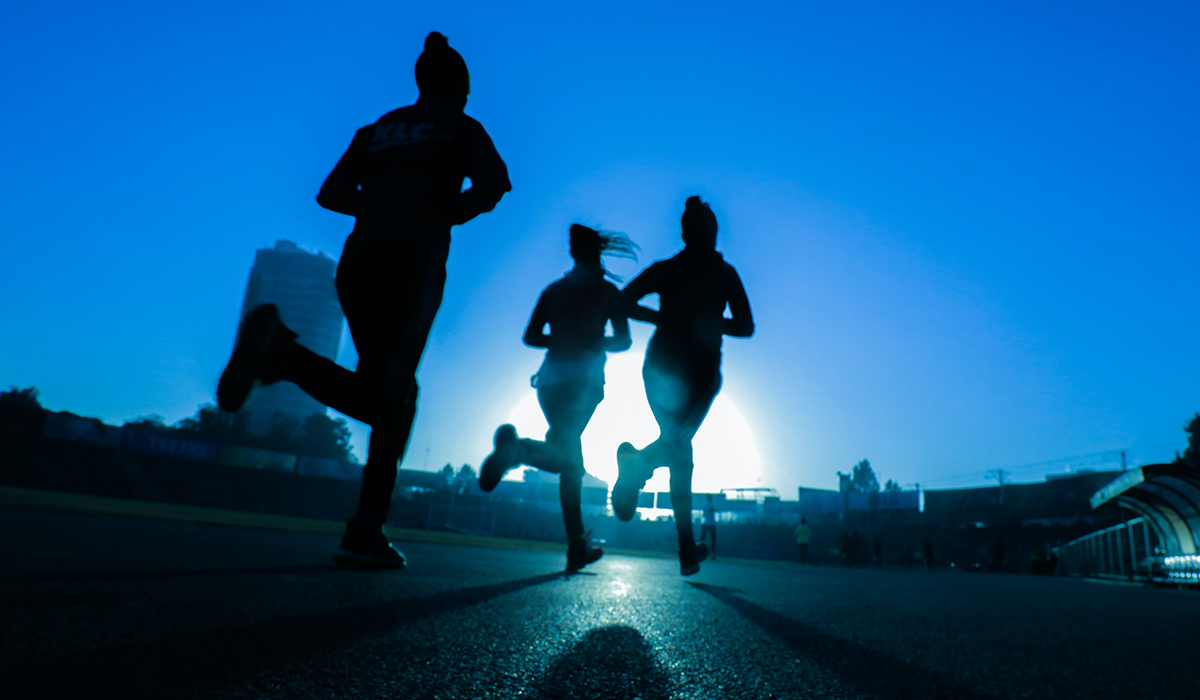
WHAT WOULD YOU DO IF YOU WERE TOLD THAT THERE WAS A PRODUCT THAT COULD DO ALL OF THE FOLLOWING?
- Get your weight down
- Increase your brain power
- Improve your sleep
- Decrease your risk of colon, breast, and uterine cancer
- Improve your heart health
- Decrease symptoms of depression and anxiety
- Increase your life span
Odds are, you would run at full-speed to the nearest store to get it — and if you
did that, you would have it: the product is exercise!
Exercise even in moderate amounts has a phenomenal host of health benefits. Walking,
running, dancing, swimming — doesn’t matter what you do, as long as you are getting
out of your chair and doing it!
With that in mind, please consider getting your team together and signing up for the
Sports Medicine Club walking/running challenge! Several of our faculty will be setting
up teams and challenging the students, residents, and staff.
August 23, 2021
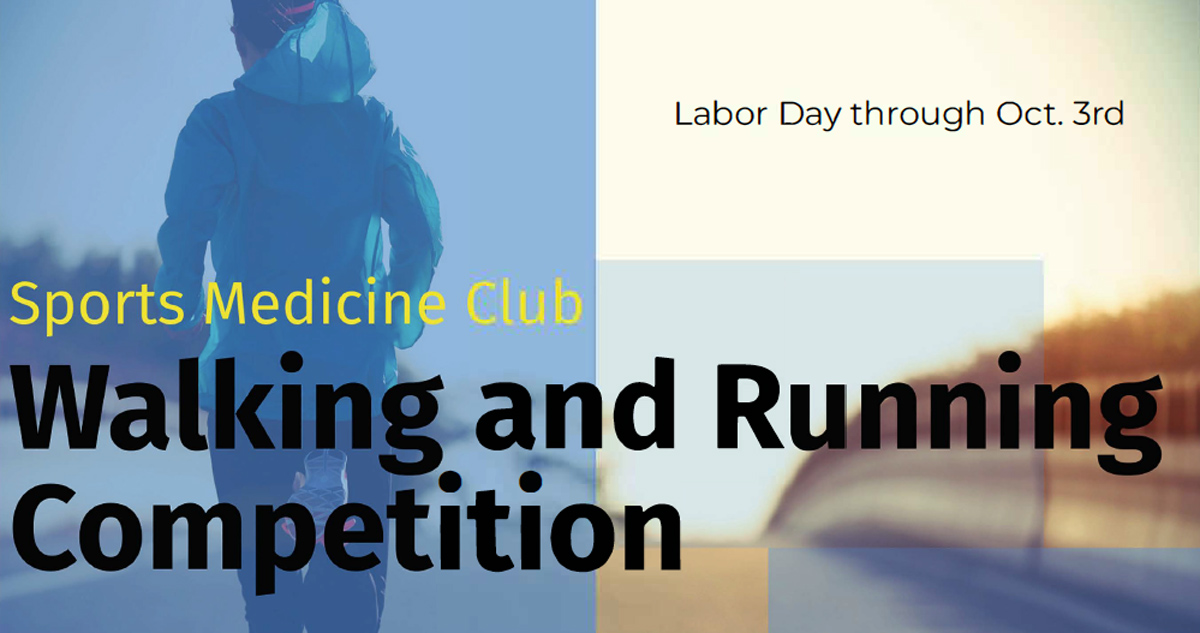
Walking and Running Competition
Sign up with your friends to compete with other teams to log as many miles as you can walking and running using the Strava app from Sept. 6 to Oct. 3. All of the proceeds will go towards a nonprofit organization of the winning team's choice. The members of the winning team will also receive a gift card sponsored by our Student Health and Wellness club.
August 16 , 2021
MEDITATION
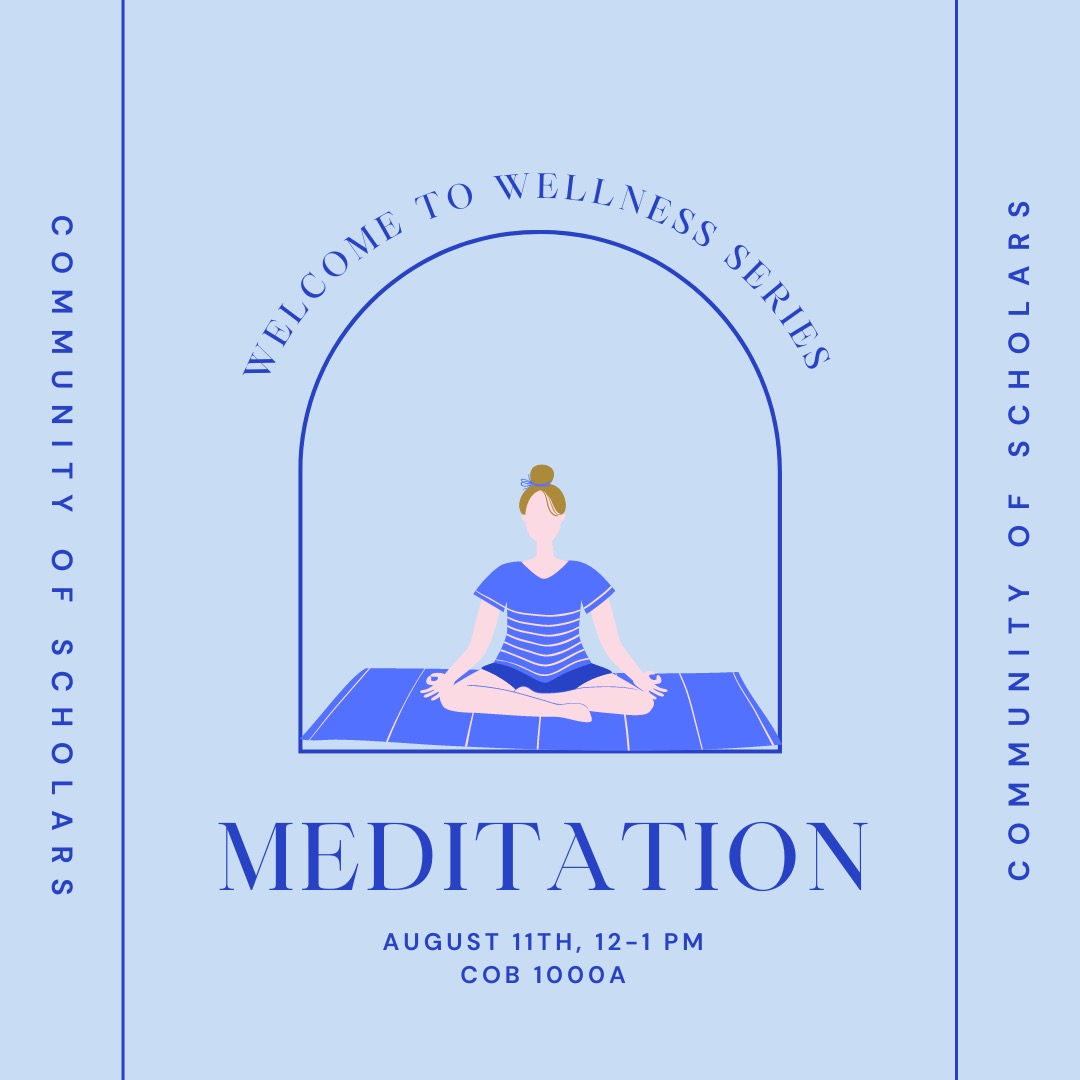
Meditation has a large number of benefits for mind, body, and spirit – but consistent
practice is needed to tap into the benefits. Consider starting the day with 5 minutes
of meditation – or even 1 minute – using one of the tools below and working up over
time to a level that’s right for you. And remember, the key to meditation success
is practice, practice, practice!
Meditation resources:
As cases of COVID-19 rise nationwide, we're going to move our upcoming yoga and tai
chi introductory sessions to the spring.
August 2, 2021
MEDITATION
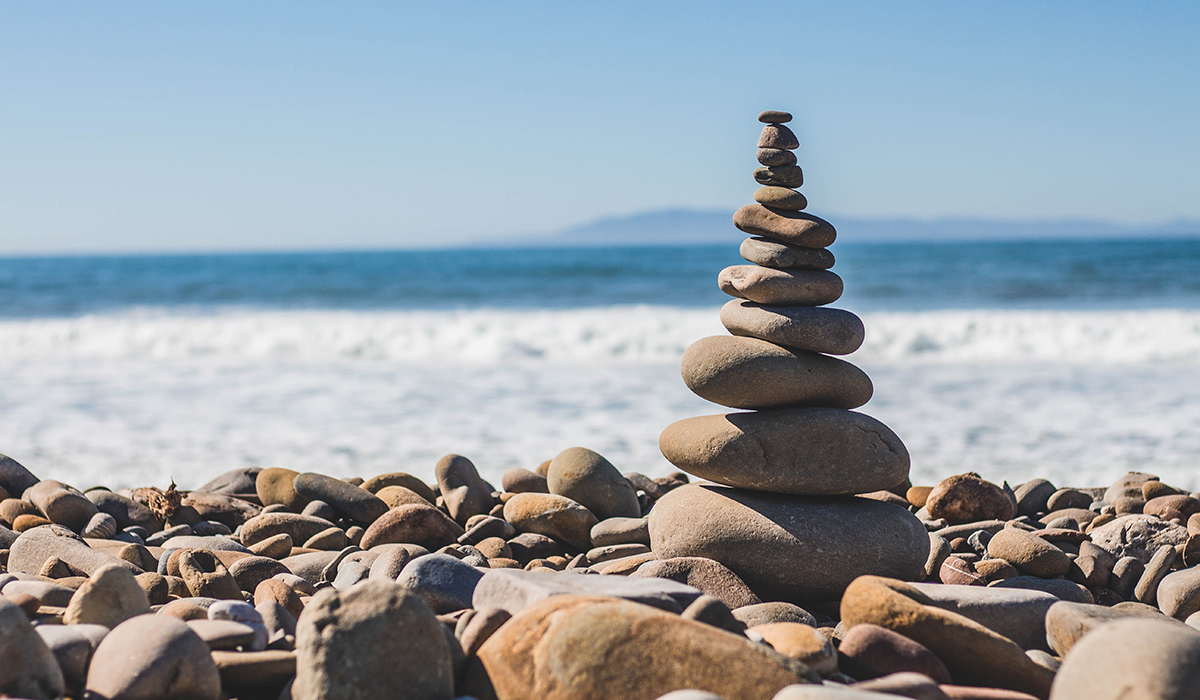
We've all heard about meditation and the many wonderful health benefits associated
with regular practice. But what is it really and why does it work? A recent review article from the Mayo Clinic described meditation as a type of mind-body
complementary medicine that produces a relaxed state.
Meditation is "an umbrella term for the many ways to a relaxed state of being." There are different
ways to meditate and achieve inner peace: guided meditation, mantra meditation, and
mindfulness meditation are a few examples. But what all forms of meditation have in
common is focusing attention on the present and relaxed breathing.
Hundreds of studies have been conducted on the benefits of meditation for emotional
health and selected medical conditions such as chronic pain or fibromyalgia. And the
vast majority of studies show that meditation can improve a variety of illnesses such
as insomnia or anxiety. That doesn't mean that meditation is a complete substitute
for western medicine — but it is a very, very helpful adjunct!
So how does it work?
Well, researchers still aren’t exactly sure. In some studies, patients who practiced mindfulness mediation had actual functional MRI changes in their amygdala (the little almond-sized collection of neurons that processes a lot of our emotions). Other studies have shown that practicing meditation increases the volume of grey matter in the brain in frontal cortex areas (so we "think" more positively) — and some have shown it increases the thickness of the hippocampus (which sits next to the amygdala and helps us with memory). While we may not be sure exactly why meditation works, thousands of years of human experience assures us that it does.
"Meditation helps decrease stress responses, anxiety, and depression by positively affecting the 'fight or flight' response. Memory and learning improve by increasing viso-spatial processing, working memory, and executive functioning. Creativity soars when practicing present-moment awareness as does inner peace and compassion with regular meditation. Finding balance by taking care of yourself and others might just be the key to it all."
July 26, 2021
A FOCUS ON SLEEP
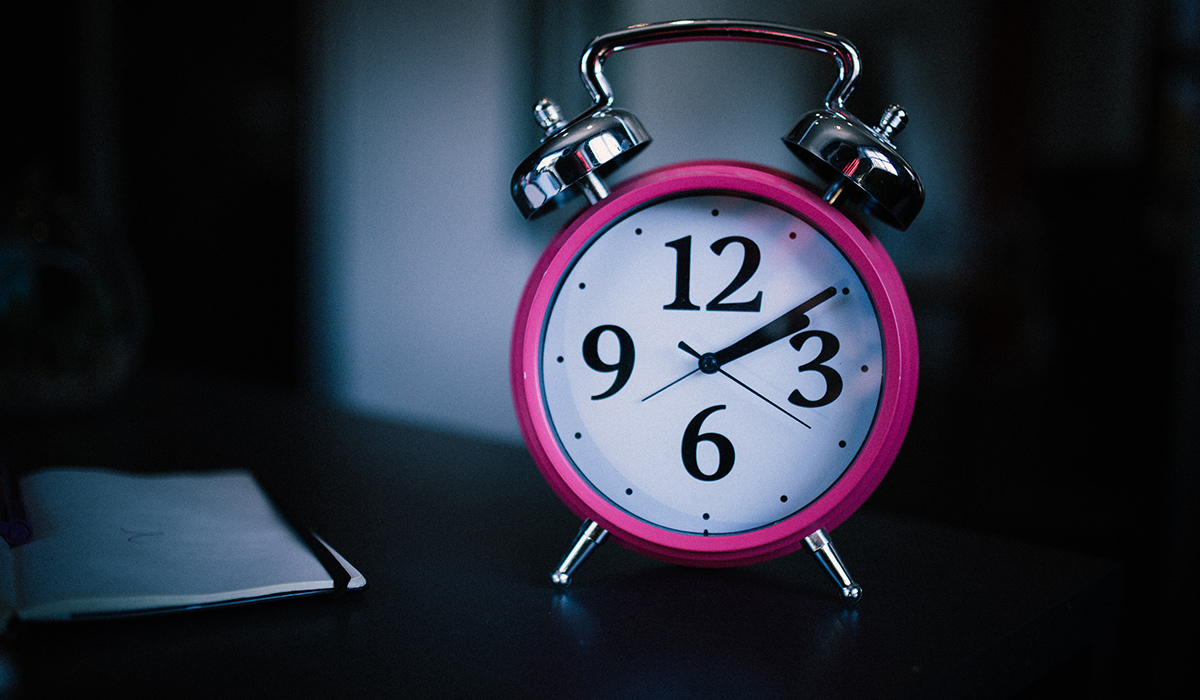
“Sleep that knits the raveled sleeve of care…”
― William Shakespeare, "Macbeth"
Did you know that inadequate sleep:
- Increases the risk of dementia in later life
- Decreases short- and long-term memory
- Increases the risk of anxiety, depression, high blood pressure (and everything that follows that)
- Decreases immune system function and sex drive
- The list goes on and on!
While there are variations in sleep requirements based on genetics, environment, etc,
the average adult needs at least 7 hours of sleep a night. We’re just starting to understand why we need adequate sleep: several recent studies have suggested that neurons deflate
by approximate 60% during sleep allowing the brain’s glymphatic system to remove brain
damaging B-amyloid and tau toxins – at least in mice.
Most Americans average less than the recommended 7 hours of sleep a night, which isn’t
enough time for the brain to clean out the toxins. And most Americans no longer even
recognize common signs of sleep deprivation. Yes, it’s not normal to fall asleep within
5 minutes if you’re sitting in a dark warm room listening to a boring lecture — day
dreaming, fidgeting, looking around — yes. Sound asleep — no.
The table below from WebMD highlights some of the other signs that you may not be getting enough shut-eye:
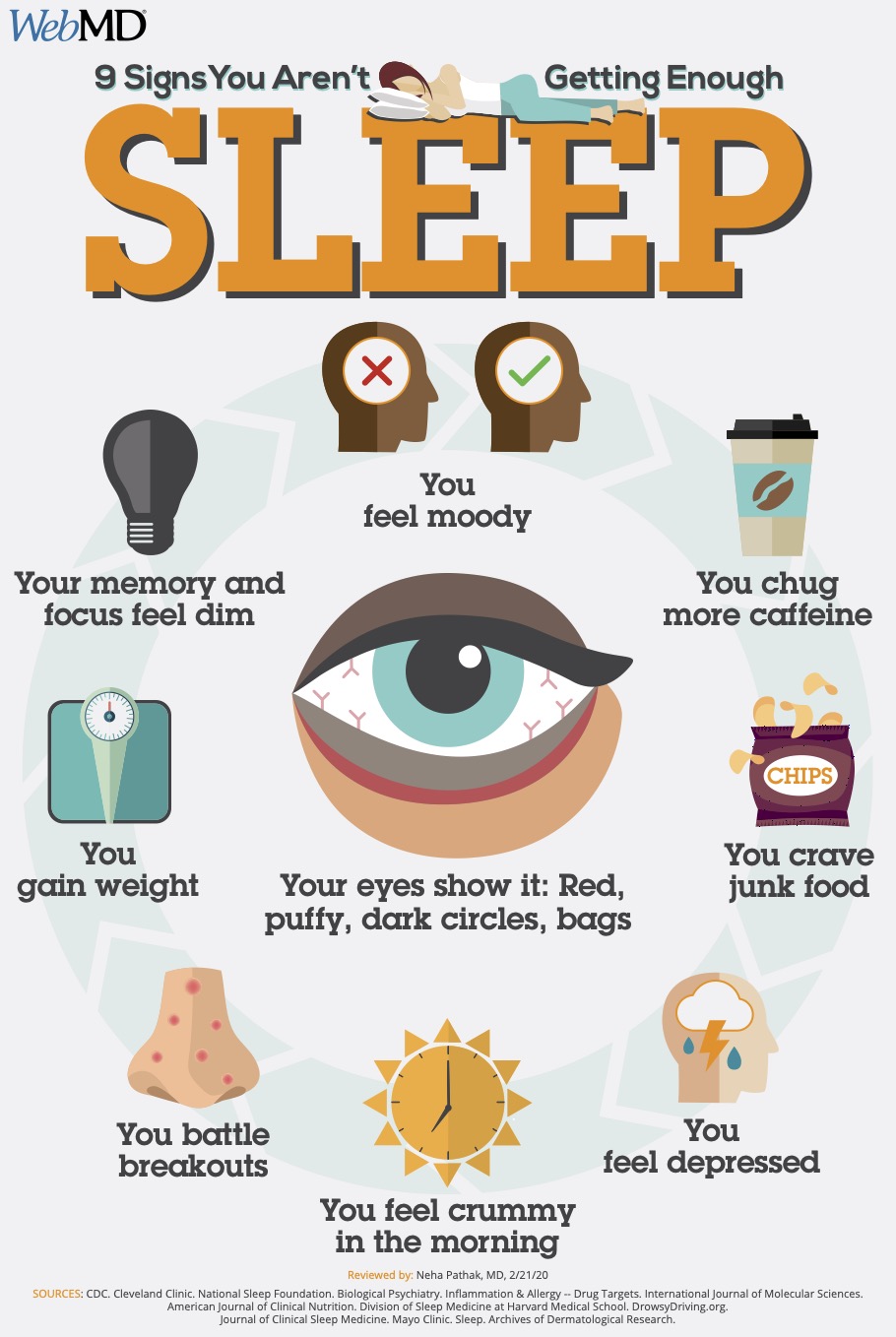
So, here’s a challenge for the next four weeks: try to practice good sleep hygiene (get off the computer an hour before bedtime, cut out the afternoon /evening caffeine,
set and keep an adequate sleep schedule).
And if you’re having trouble sleeping, see your doctor and reach out to Impact Solutions. If stress, depression, medications (even common over the counter ones) are disrupting
sleep, these need to be addressed. Sweet dreams!
Upcoming Wellness Events
On the second Wednesday of each month in the academic year, the Student Health and Wellness Club will be hosting a one-hour wellness event at noon to introduce an activity that may
help improve resilience, decrease burnout, and increase wellbeing – very important
in the pursuit of happiness!
All medical students, residents, faculty, and staff are invited to attend and try
a new wellness activity. So mark your calendars for the following events (locations
to be announced):
- August 11 – Meditation, 12 to 1 p.m. (location TBA)
- September 8 – Tai Chi, 12 to 1 p.m. (location TBA)
- October 13 – Beginners Yoga, 12 to 1 p.m. (location TBA)
- November 10 – Massage Therapy, 12 to 1 p.m. (location TBA)
July 19, 2021
THE LOCAL WELLNESS SCENE

As we roll out the year in wellness, let's take a moment to list some of the local
resources available right in our own backyard – both at The University of Toledo and
in the local community!
Various wellness resources are available for UTCOMLS faculty, students, and staff
on both campuses:
Did you know that at The University of Toledo Health Science Campus, we have two walking paths – one indoor and one outdoor? The Morse Fitness Center is also open during the week for workouts and sports, including a variety of fitness
programs for members.
The Office of Student Advocacy and Support (OSAS) houses the links to the Student Mental Health and Wellness services, where students can receive confidential services 24/7. Additionally, there are multiple Wellness Workshops available such as: Stress Management, High Risk Drinking, Wellness Bucket, What is
in Your Cup, Gratitude Journaling and Goal Setting. That's just a small sampling of
offerings and activities.
On both Health Science Campus and Main Campus, the Rocket Wellness program hosts a wide selection of wellness programs and activities
ranging from Wellness Wednesday (this includes various activities such as nutrition chats, cardio drumming, kick
boxing) to monthly webinars to the employee assistance program — Impact Solutions. Visit the website and check out the extensive list of programs and services that are
offered.
Finally, in our local community, there are a vast number of activities and places that add joy and health to our
lives – the Metroparks (including kayaking at some of the parks), Toledo Zoo, Toledo Art Museum, Toledo Botanical Garden, Maumee Bay State Park, MacQueen Apple Orchard, and the list goes on! Check out the Toledo Calendar of events to see additional wellness events going on
in Toledo.
Upcoming Wellness Events
On the second Wednesday of each month in the academic year, the Student Health and Wellness Club will be hosting a one-hour wellness event at noon to introduce an activity that may
help improve resilience, decrease burnout, and increase wellbeing – very important
in the pursuit of happiness!
All medical students, residents, faculty, and staff are invited to attend and try
a new wellness activity. So mark your calendars for the following events (locations
to be announced):
- August 11 – Meditation, 12 to 1 p.m. (location TBA)
- September 8 – Tai Chi, 12 to 1 p.m. (location TBA)
- October 13 – Beginners Yoga, 12 to 1 p.m. (location TBA)
- November 10 – Massage Therapy, 12 to 1 p.m. (location TBA)
July 12, 2021
WELL-BEING ASSESSMENTS 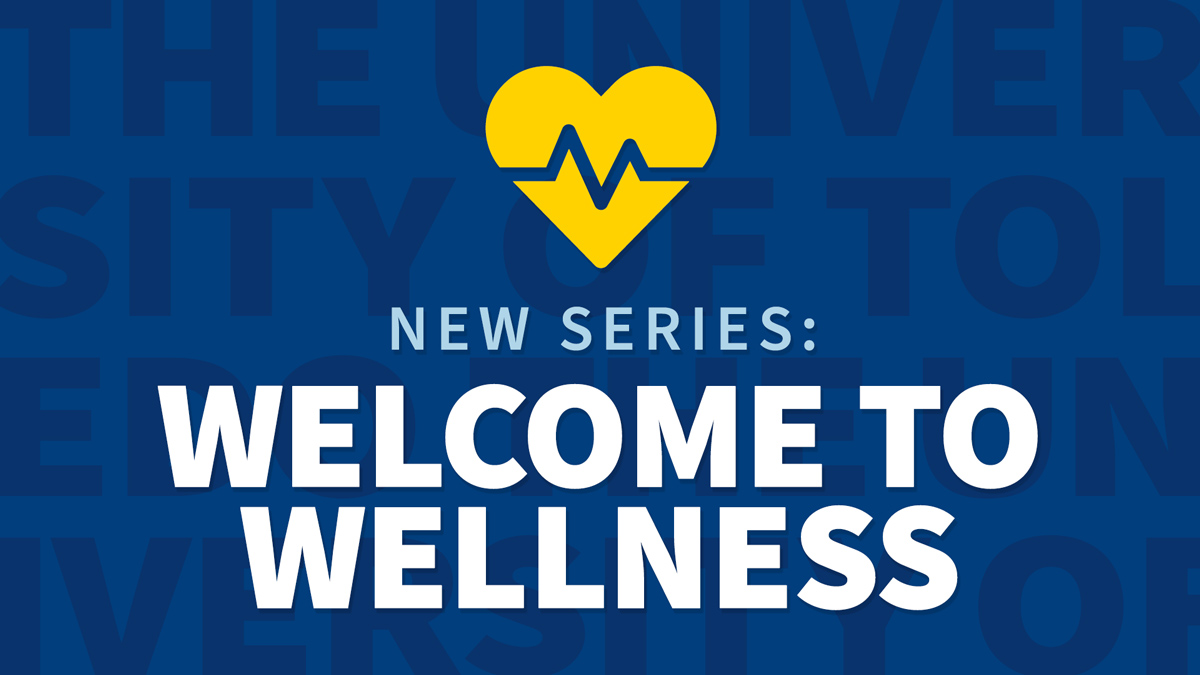
Upcoming Wellness Events
On the second Wednesday of each month in the academic year, the Student Health and Wellness Club will be hosting a one-hour wellness event at noon to introduce an activity that may
help improve resilience, decrease burnout, and increase wellbeing – very important
in the pursuit of happiness!
All medical students, residents, faculty, and staff and invited to attend and try
a new wellness activity. So mark your calendars for the following events (locations
to be announced):
- August 11 – Meditation, 12 to 1 p.m. (location TBA)
- September 8 – Tai Chi, 12 to 1 p.m. (location TBA)
- October 13 – Beginners Yoga, 12 to 1 p.m. (location TBA)
- November 10 – Massage Therapy, 12 to 1 p.m. (location TBA)


